FIGHTING FOR CHICAGO’S PLACE IN HIP-HOP HISTORY
Darrell “Artistic” Roberts of Chi-ROCK Nation has worked to document the culture he loves for more than three decades—and now he’s finally publishing a book.

 By LEOR GALIL
By LEOR GALIL




Darrell “Artistic” Roberts of Chi-ROCK Nation has worked to document the culture he loves for more than three decades—and now he’s finally publishing a book.

 By LEOR GALIL
By LEOR GALIL



mind, live podcast recordings are a performance medium all their own.
14 Lit This City Is Killing Me explores how systematic forces contribute to mental health issues in Chicago.
20 Plays of note Prop Thtr’s devised play about the Holocaust focuses on resistance, bravery, and survival; Silent Theatre Company runs its mouth in Incomplete Conversations; and Sugar in Our Wounds offers a heart-tugging portrait of Black queer love in the Civil War era.
04 Joravsky | Politics There’s enough “mayo” in the TIF slush fund to settle the teachers’ strike.

06 Isaacs | Culture Complaints from the production team of His Shadow have opened a painful discussion for Berwyn’s 16th Street Theater and head Ann Filmer.
08 Dukmasova | Housing It took almost five months to get recording equipment working in eviction court. Will it make a difference for landlords and tenants?

11 Restaurant Feature Restless innovator and Michelin-starred chef Phillip Foss bares his soul in a new graphic novel.
13 Comedy Part hangout, part celebration, part theater of the
15 Dance In Alexandra Bachzetsis’s Chasing a Ghost, relics of a powerful past form the backdrop for dances about exchangeability.

16 Interview Jimmy Carrane, a mainstay of 1990s solo and improv scenes, tells us what he’s been doing for the past 18 years in World’s Greatest Dad(?).
18 Preview In Tru, a young man wrestles with mental illness— embodied as a woman.
18 Upcoming November live performance heats up with worldpremiere plays, works-in-progress dance pieces, and cured-meat comedy.
23 Movies of note Black and Blue half-heartedly explores being African American, female, and a police officer; no amount of gorgeous costumes can save the clumsy Paradise Hills; and Linda Ronstadt: The Sound of My Voice shies away from any real criticism.

CHICAGO
|
for more than three decades—and now he’s finally publishing a book.
29 In Rotation Current musical obsessions of VJ Darrell Gordon, DJ Ken Wong, and the Reader’s Salem Collo-Julin
30 Shows of note Djunah, the Hu, Preservation Hall Jazz Band, and more this week
35 Early Warnings William Basinski, Destroyer, Mura Masa, and more just-announced concerts
35 Gossip Wolf New releases from chilly postpunks Ganser, instrumental guitar-and-drums duo Sun Speak, and “queer twee pop” band Joey Nebulous
36 Savage Love Dan Savage offers advice for a person held back by a little dick, a teacher ISO a second job as a sex worker, and more.
Jobs
Apartments & Spaces
Marketplace
24 Galil | Feature Darrell “Artistic” Roberts of Chi-ROCK Nation has documented the culture he loves

Photographer Joeff Davis captured the day of demonstrations.
Movie Tuesday: So long for now
Final films from directors to mark our farewell—for now—from Ben Sachs.
More than 30,000 ballots (over 900,000 votes) were cast in more than 300 categories. Celebrate with us on November 19! Tickets at chicagoreader.com/party
2019 |
TO CONTACT ANY READER EMPLOYEE, E-MAIL: (FIRST INITIAL)(LAST NAME) @CHICAGOREADER.COM
PUBLISHER SCARY BRAIN EDITORS IN CHIEF SUJAY KOOOOOOOOMAR, SCARIN HAUNTINS DEPUTY DEMON THE LATE HEAD-ON-A-PLATE KATE CREATIVE LEAD SUECIFER KWONG DIRECTOR OF PHOTOGRAPHY JAMPIRE RAMSAY MUSIC EDITOR PHILIP “THE BRAIN THAT WOULDN’T DIE” MONTORO
THEATER AND DANCE EDITOR SKERRY REID ASSOCIATE EDITOR JAMIE LUDWICKED WITCH OF THE MIDWEST SOCIAL MEDIA EDITOR BOOANNA WAILIN SENIOR WRITERS DEANNA “MISTRESS OF THE DARK” ISAACS, BOO JORAVSCARY, MIKE CRUELLA STAFF WRITERS MAYA DUKMASOVA (SCARY ENOUGH AS IT IS), LEOR GHOUL-LIL
EDITORIAL ASSOCIATE S. NIGHTMARE LANE LISTINGS COORDINATOR SALEM THE CAT FROM SABRINA CANNIBAL-HOLOCAUST-GHOULIN’ FILM LISTINGS COORDINATOR
PATRICK-OR-TREAT FRIEL
GHOSTS AND GREMLINS ED BLAIR, LUCA CIMARUSTI, MARISSA DE LA CERDA, SHERI FLANDERS, JACK HELBIG, IRENE HSAIO, MONICA KENDRICK, STEVE KRAKOW, NOËLLE D. LILLEY, JAMIE LUDWIG, MAX MALLER, BILL MEYER, SCOTT MORROW, J.R. NELSON, JAMES PORTER, LEAH PICKETT, BEN SACHS, DMITRY SAMAROV, CATEY SULLIVAN
DIRECTOR OF DIGITAL JOHN DEADLEVY DIRECTOR OF PUBLIC ENGAGEMENT & PROGRAMS CURSE N’ KAZA
ADMINISTRATIVE ASSISTANTS
JANAYA SCREAM, YAMPIRE BOOMINGUEZ
312-392-2970, DISPLAY-ADS@CHICAGOREADER.COM CLASSIFIEDS: SALEM@CHICAGOREADERCORP.COM
SALES DIRECTOR ATTACK OF THE 50 FT. PATTI FLYNN
VICE PRESIDENT OF SALES AMY MATH-SCREAMY CLIENT RELATIONSHIP MANAGER TED-O-LANTERN PIEKARZ
SENIOR ACCOUNT REPRESENTATIVES BOB GHOULITH, LENI MANAA-HALLOWEEN, LISUSPIRIA SOLOMON CLASSIFIED SALES MANAGER THRILLER ROGERS
NATIONAL ADVERTISING VOICE MEDIA GROUP 1-888-278-9866
VMGADVERTISING.COM
JOE LARKIN AND SUE BELAIR
DISTRIBUTION CONCERNS distributionissues@chicagoreader.com 312-392-2970

BOARD PRESIDENT DOROTHY R. LEAVELL TREASURER EILEEN RHODES SECRETARY JESSICA STITES AT-LARGE SLADJANA VUCKOVIC CONSULTANT CAROL E. BELL
READER (ISSN 1096-6919) IS PUBLISHED WEEKLY BY STM READER, LLC 2930 S. MICHIGAN, SUITE 102 CHICAGO, IL 60616 312-392-2934, CHICAGOREADER.COM
COPYRIGHT © 2019 CHICAGO READER PERIODICAL POSTAGE PAID AT CHICAGO, IL ALL RIGHTS RESERVED. CHICAGO READER, READER, AND REVERSED R: REGISTERED TRADEMARKS ®

There’s enough “mayo” in the TIF slush fund to settle the teachers’ strike.
By BEN JORAVSKYIf Mayor Lightfoot wants to end the teachers’ strike, I know where she can find the money to settle the union’s demands about class size and hiring nurses, librarians, and counselors.

She should just look in the mayonnaise jar.
I use that term to tip my Bulls cap to the unnamed mayoral aide who coined it as a clever way to refer to the TIF slush fund.
That would be the fund that fills up every year with hundreds of millions of property tax dollars that you, the property taxpayer, pay whether you realize it or not.
Over the years, I’ve called the TIF slush fund everything from a honey pot to the banana stand, a nod to a line from Arrested Development, one of my favorite sitcoms.
But mayonnaise jar? Not bad. Hey, unnamed adviser—when your City Hall days are over, you might want to give column writing a try.
Having said that, I must disagree with the essential point the aide was making. The com-
ment appeared in the Sun-Times soon after Mayor Lightfoot withdrew about $300 million from the tax increment financing slush fund to help pay city and school bills.
“This is, in essence, scraping the mayonnaise jar,” the aide told the Sun-Times . “We went through and aggressively surplussed every single TIF.”
Yeah, well, with all due respect—that’s what mayoral aides have been telling reporters since Mayor Richard M. Daley invented the TIF scam in the 90s.
My guess is there’s a lot more mayonnaise in that TIF jar. Just how much, I can’t say, because the mayor—taking a page from Daley and Mayor Rahm—won’t tell us. An outrage for another column.
The bottom line is that each year more property tax dollars pour into the TIF accounts. Last year, they collected $841 million, an all-time high.
The unnamed aide reminds me of a kid who picks up a chicken leg and throws it away after taking one bite. Man, there’s a lot more chicken on that bone.
Hey, there’s another new nickname for you—the TIF chicken bone.
Tom Tresser—the north-side activist who founded the TIF Illumination Project—estimates there’s about $1.5 billion in the TIF slush fund. He gets that number by going through the city’s annual TIF reports and tallying up the reserves that are itemized in 145 di erent PDFs.
It’s possible that the city has obligated some of that $1.5 billion for projects since the annual reports were filed this summer. But the slush fund has got to be more plentiful than a scraped-out mayonnaise jar.
I understand why the mayor and her may-
onnaise-loving aides might be reluctant to dip into TIF reserves to settle the teachers’ strike.
They may not want to set a precedent—the police and fire department unions may be eyeing the mayonnaise jar to settle their contract demands as well.
Or she might have plans for the money. Or maybe she just wants to spite the leadership of CTU.
But the money’s there. The kids need more nurses and librarians, and lower class sizes. Plus Chicago Public Schools should have dibs on more than half of the cash stashed in the slush fund. And here’s why . . .
When the City Council and the mayor create a TIF district, they freeze the amount of property in that district CPS can tax for 23 years.
Take the controversial Lincoln Yards TIF, for example. Located in a booming north-side neighborhood, the area would undoubtedly be the site of new homes and projects even without the TIF handout.
Without the TIF district, CPS could raise millions in property taxes from new development in the Lincoln Yards area. How many millions, I don’t know—the city never does an adequate analysis of any TIF proposal.
But it’s a helluva lot more tax dollars than CPS will get from Lincoln Yards, as big as it is, now that the schools’ property tax yield is frozen for 23 years thanks to the TIF.
What does CPS get for giving up property tax dollars in the Lincoln Yards TIF district? Well, umm, nothing.
Actually, it’s worse than nothing. They could lose money on the deal. If kids who live in Lincoln Yards go to public schools, CPS will have to hire more teachers to teach them. And these are going to be wealthier kids—so CPS can’t get away with packing 40 of them into
a classroom like they do with students in the poor parts of town.
From CPS’s perspective, it would have made more financial sense if the city—then led by Mayor Rahm—had exempted the schools from the Lincoln Yards TIF (and the 78 TIF, for that matter).
That means the schools would get to fully tax the area, even as it’s developed. It would mean less of a handout for the developer, but more money to hire librarians, social workers, and counselors over the next 23 years.
There’s a precedent for exempting CPS from a TIF district. Mayor Rahm did it with the transit TIF that runs along the Red Line.
But the two TIF districts symbolize di erent eras in Rahm’s reign. In 2016, when he pushed through the transit TIF, Rahm was facing protests over the Laquan McDonald shooting.
By exempting CPS from the transit TIF, he minimized protests over it. He also allowed CPS to continue to reap the full property tax yield from upscale north-side property.
So good for you, Mayor Rahm. On the other hand . . .
He strong-armed the City Council into passing Lincoln Yards and the 78 at his last meeting before he left o ce. He didn’t have to worry about the public outcry. You might say he left City Hall as he entered it—with both middle fingers raised high.
Well, enough about Mayor Rahm. Back to Mayor Lightfoot. Fair is fair, Madame Mayor.
The time’s come to end this strike with the mayonnaise the city took from the schools in the first place.
I hope by the time you read this column, she will have done just that. v
@joravbenStriking Chicago teachers march through downtown on October 17. CHARLES EDWARD MILLER
The Chicago Reader is community-centered and community-supported.





You are at the heart of this newspaper. Founded in 1971, we have always been free, and have always centered Chicago. Help us to continue to curate coverage of the diverse and creative communities of this fabulous city.




Your donation keeps the presses rolling. CHIP IN HERE: www.chicagoreader.com/members

Complaints from the production team of His Shadow have opened a painful discussion for Berwyn’s 16th Street Theater and head Ann Filmer.
By DEANNA ISAACSLoy A. Webb’s His Shadow: A Parable, enjoyed an enviable premiere run at Berwyn’s 16th Street Theater this fall. The play, about a Black football player torn between his own ambition and a call to social activism, won strong reviews for the story, the three-member cast, the direction, and every other element of the production. It wasn’t until October 20, a day after closing, that the show’s behind-thescenes drama erupted on social media.

That’s when director Wardell Julius Clark, posting on Facebook and Twitter (at #TalesfromHisShadowat16thStreet), began describing a litany of di culties encountered at the tiny suburban venue, using a familiar rhetorical setup: “Have you ever had a yt artistic director flash the black power fist to an all black cast, while co-opting language from a poc in the audience, filled with excitement, with no awareness to how uncomfortable they are making the cast? I have.”
Clark was joined by the production’s dramaturg, Regina Victor, and associate director, Sydney Charles, both of whom are also Black (“I have never been so depleted and disrespected as an artist during a process,” Charles wrote). And on October 23, they in turn were joined by another supporter: 16th Street’s managing director, Marissa McKown, who had this to say: “Please know these artists are professional, compassionate truth-tellers, who tried for months to find another solution.”
McKown, who’s white, added: “It’s not just this one show . . . not just black artists . . . ”

The complaints were aimed primarily at artistic director Ann Filmer, who cofounded 16th Street in 2007 as a program of the North Berwyn Park District that would bring Equity theater at a bargain price to the park district’s 49-seat cultural center theater. In line with its mission of “inclusivity and a ordability,” 16th Street has produced 63 plays by Illinois playwrights, 54 plays by women, 36 plays
by writers of color, and 25 world premieres. With a top ticket price of $22 (less for Berwyn residents) and its location in a historically blue-collar, now mainly Latinx community, 16th Street has built a reputation as a gritty professional theater of the people.
What happened? “Mismanagement wrapped in institutional racism” is how Clark summed it up when I reached him by phone last week.
The problems he and Victor cite include disagreement about an industry night (they say Filmer scheduled it for the convenience of a critic, then arranged to fill the house with high school students); an extension announced in a press release before anyone working on the play had been informed; hiring Victor at half the theater’s usual dramaturg’s rate; programs that, among other problems, misspelled Clark’s name (and an unwillingness to reprint them, even when Victor o ered to foot the bill); and, after the team complained about these and other issues, being “pawned o ” to an artistic associate, Esteban Cruz, who was brought in to take over Filmer’s role as His Shadow’s producer. When Clark protested that it was racist to hand o an all-Black cast to a Brown person, he says Filmer responded that he should take his issues to Joseph Vallez, the North Berwyn Park District executive director.
The last straw came on the final weekend, Clark said, when, although there was no problem at the theater, “someone inside was calling the cops.” The irony was inescapable: Berwyn police showed up three times that weekend, Clark noted, “and this is a show about police brutality.” On Facebook, he wrote, “This is what intimidation looks like.”
“This kind of racism can be relatively common,” Victor told me, adding that “had the mismanagement not been so egregious”—and the cops not been called—they might have let it go, although they felt “undervalued from the beginning.” Through it all, Victor adds, McKown “was trying to help.”
A lot of these complaints—minus the racism—strike a familiar chord for Josh Sobel, who directed Koalas at 16th Street a year ago and is now in graduate school at California Institute of the Arts. Sobel, who isn’t Black, told
me he encountered “sheer unprofessionalism, willful ignorance, and an unwillingness to listen or engage” from the 16th Street administration. McKown, he added, was “the one person I could go to there and be heard.”
But he thinks the situation is far from uncommon.
“Theater companies can get away with a lot because of the storefront nostalgia” we have, especially in Chicago, Sobel said. “You get so enamored with the idea, it allows people to accept ‘this is the way of things.’ But there’s a cultural reckoning now—a conversation to be had about what we let slide. Things that were taken for granted aren’t anymore. And racism through arrogance and ignorance is still racism.”
Cruz, via e-mail, and from a “personal perspective” only, makes this argument: “Callout culture and the good work of groups like Not in Our House have brought a great deal of accountability. . . . But when these tactics are applied to folks who are not deserving of such severe consequence, it will eat away at us. [Filmer] has been walking the walk for 12 years at this theater. . . . We need to know who our real enemies are because if [in the demand for perfection] we discard those who are really our allies, there may be no one left. It is my hope that we live in a culture where missteps and failures can be used as a learning opportunity.”
That’s a sentiment echoed by Webb. “I wasn’t there. My team was on the ground, and I totally stand with them,” the playwright said on the phone from the west coast, where she’s writing for television. “Institutional racism exists all over the country, and in bigger theaters too,” Webb said. “We must call it out. But I’m solution based. What do we do once we call it out? To eradicate racism on an industry-wide level? If someone has really taken accountability for their actions, and wants to learn how to be better, I feel we should come to the table and tell them, ‘Hey, this is what you need to do.’ ”
Filmer says she can’t comment. Vallez says the North Berwyn Park District is conducting an investigation. v
@DeannaIsaacs


 HOUSING
HOUSING
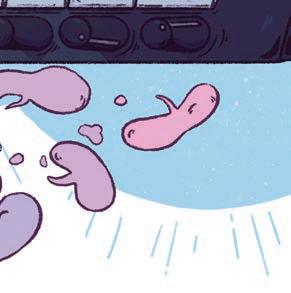


It took almost five months to get recording equipment working in eviction court. Will it make a difference for landlords and tenants?

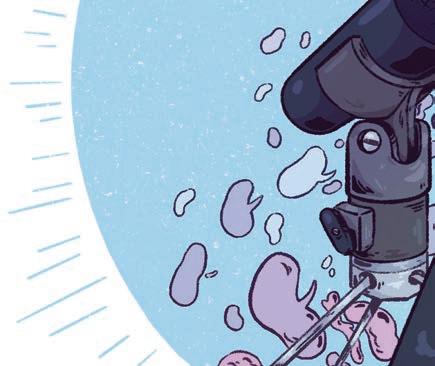 By MAYA DUKMASOVA
By MAYA DUKMASOVA
On Tuesday, October 22, more than four months after installation of court recording equipment began in all five of the eviction courtrooms at the Daley Center, green lights were shining on the mikes but no recordings were being made. It took years of lobbying by the Chicago Appleseed Fund for Justice and other groups to convince the Administrative O ce of the Illinois Courts to allocate some $370,000 to supply Chicago’s eviction courtrooms—which process about 20,000 cases every year—with microphones for creating transcripts of court hearings. Physical installation of the equipment was completed in early September, and since then, according to the chief judge’s o ce, software problems have gotten in the way of generating recordings. After the Reader inquired last week about when the equipment was expected to be fully functioning, the o ce confirmed that recordings finally began last Friday, October 25.
“We are experiencing a technical issue that is preventing the digital recordings from being automatically downloaded directly to the . . . digital recording server, where the court reporters will access the recordings to provide transcripts upon request,” Pat Milhizer, a spokesman for the O ce of Chief Judge Timothy Evans, wrote in an e-mail.
“We are working with the [Administrative Office of the Illinois Courts] and the Cook County Bureau of Technology to resolve this issue. In the meantime, we are in the process of developing a manual procedure to im-
plement the digital recording system in the event that we are unable to quickly resolve the technical issue.”


While the presence of court reporters with stenography machines is standard in all criminal courtrooms in Cook County, on the civil side of the justice system many courtrooms aren’t equipped with recorders or sta ed by reporters. Eviction courtrooms lost all reporters and recording equipment in the early 2000s due to budget cuts. Since then, unless a litigant or attorney hired their own court reporter to accompany them to
a hearing, no records of the proceedings have been made as hundreds of thousands of Cook County residents faced the loss of their homes. Most eviction cases fi led end with the tenant being ordered out; landlords’ chances of winning cases are bolstered by the fact that about 80 percent of them have lawyers while 80 percent of tenants do not.
On that Tuesday morning, N’Shanell Murphy was in court facing eviction by landlord Charles Muhammad for not paying the $900 monthly rent since August. Murphy, armed with a thick envelope of photographs she
printed at Walgreens, was trying to explain to Judge David Skryd that she had withheld rent due to a persistent cockroach infestation in her South Chicago apartment. She’d even brought in printed screenshots of her text messages pleading with Muhammad to take care of the roaches and other problems in her unit. “I told him I wouldn’t pay the rent until he fi xed the problems,” Murphy, who was in court by herself, explained to the judge. Muhammad’s lawyer, Ralanda Webb, said they were seeking an eviction order. The whole trial took less than five minutes. Skryd didn’t
ROGERSlook at Murphy’s pictures, ordered the eviction, and said she’d have a week before the Cook County Sheri ’s O ce was authorized to remove her.
Outside the courtroom, Murphy said that she’d lived on the second floor of the two-fl at building for five years. Muhammad had purchased the building from a previous owner last February. Since then, Murphy said the cockroaches in her three-bedroom apartment have gotten so bad that they cluster around door frames, congregate in the fridge, and crawl into her three kids’ bookbags. “They’re taking roaches to school, do you know how embarrassing that is?” she said. “My youngest is depressed.” She said she’d tried to exterminate on her own and showed photo after photo of the bugs, along with pictures of rotting plumbing and bathroom faucets that require pliers to turn. Though her landlord’s lawyer had o ered her a deal to pay back some of what she owed, get more time to move out, and have her eviction case sealed, Murphy thought it was wrong that she should have to pay anything at all for a unit her landlord was failing to fi x. She had hoped the judge would see things from her perspective, especially since a city inspector had just been out to the property on October 10 and, per the online log of building code violations, documented rotting doors, crumbling walls, high weeds, mold, broken windows, leaks, standing water and raw sewage smells in the basement, mice and roach infestations, and missing smoke detectors.
Murphy said she’d be looking for a lawyer to help her fi ght the eviction order, but with only a week before it went into e ect and no transcript of what had happened during the trial, it would be di cult to reverse Skryd’s decision even if she had indeed been entitled to withhold her rent under Chicago’s Residential Landlord Tenant Ordinance due to the conditions in the apartment.
Lawyers practicing in eviction court and groups concerned about equal access to
justice in Cook County point to cases like Murphy’s as examples of why recording devices are crucial. According to Legal Aid Chicago’s Lawrence Wood, it’s “a distressingly common occurrence” that low-income tenants approach his o ce for help only after an eviction order has already been issued by a judge. “We have to try to discern what happened in court through nothing more than the tenant’s version of events,” Wood said. “This task is especially di cult because many if not most low-income tenants are confused by courtroom procedures, by the legal terminology that judges and plainti s’ attorneys use, and by the speed with which cases are handled.” Even if attorneys are able to reconstruct what happened at trial from a defendant’s accounts, an appeal would still be based on the defendant’s a davit, “which, unlike a trial transcript, can be dismissed as inaccurate if contested by opposing counsel or by the judge.”
One of Wood’s colleagues at Legal Aid Chicago, Michelle Gilbert, had a recent ex-

ample of just such a situation involving Judge Skryd. She’d been representing a tenant whose landlord had fi led for eviction claiming she owed less than $200 in rent. Gilbert fi led a motion to compel the landlord to provide a full ledger proving her client owed the money. Typically the opposing party would fi le a motion in response and then both sides would make arguments at a hearing before the judge decided whose request to grant. Gilbert said that on the day she expected to see a response motion from the landlord, his lawyer opted simply to ask Skryd to deny her motion, and the judge did just that. He went on to issue an eviction order; when Gilbert appealed, she argued that there were a number of mistakes in the case, including Skryd’s actions regarding her motion for the ledger. “The Illinois Appellate Court denied the piece of our appeal that had to do with the motion to compel because there was no transcript,” she said. “They presumed [Skryd] did the right thing.”
Aside from the fact that a lack of


“I don’t think there’s anything to be gained by having things happen in court that aren’t recorded. I think it’s perfectly fine and keeps everybody on the up-and-up.”
transcripts makes it hard to reconstitute the events of a hearing and ensure that judges are interpreting and applying laws correctly, the absence of court reporters and recording devices makes it hard to monitor judges’ behavior too. “We have unfortunately seen some judges make very inappropriate comments, and judges are far less likely to make such comments if they know they’re being recorded,” Wood said. He added that while it’s much less of a problem than it used to be, some judges still make statements in and outside of court that give lawyers who represent tenants cause for concern. Skryd appears to be one of those judges.
On June 18, a week after the recording equipment began to be installed in eviction courtrooms, Skryd and another circuit court judge appeared at a talk hosted by the Chicago Bar Association. According to a recording and transcript of his remarks, Skryd explained to an audience of attorneys that the recording equipment was installed in eviction court after lobbying by “special
interest groups” who “felt that indigents that appeared in those courtrooms, or litigants that wanted to appeal their case—they were at some kind of a disadvantage because they didn’t have transcripts of the proceedings.”
The groups that lobbied for the recording equipment “have an agenda,” Skryd said. “They’ll always take the example of someone who was all of a sudden removed from their home through the eviction process and they’ll take that person and feature them in some kind of article and next thing you know judges and property owners are contributing to homelessness, that it’s the judges and the property owners that are responsible for this.”
The judge went on to characterize tenants facing eviction in a way landlords frequently do: as people who just aren’t paying rent and take advantage of the time it takes to evict them through the courts to live somewhere for free and run the unit into the ground.
“People are in these places for six, eight months destroying property, have no valid claim to remain,” Skryd said.
These remarks sparked outrage among some lawyers on the tenant side of the bar, who felt that Skryd was openly admitting to a bias against tenants. (Skryd didn’t return the Reader ’s request for comment to clarify what he meant.) Some lawyers were further concerned when he later added that he planned to mute some of the mikes in his courtroom that he didn’t feel were necessary. (Mikes have been installed in front of the judge, before the judge’s bench where the litigants stand and speak during hearings, on the witness stand, and at the tables where plainti s and defendants’ attorneys typically sit; an additional portable microphone is available for on-the-record conversations outside the courtroom.) According to rules for use of the recording equipment shared by the chief judge’s office, “before starting any trial or hearing, all microphones must be un-muted. The judge should also make a general announcement to the public about the use of digital audio recording before starting their court call.”
Skryd made no such announcement before the start of his hearings last Tuesday. When asked by the Reader at the end of his call whether the recording equipment in his courtroom was functioning, Skryd curtly said, “I don’t have any information on that” as he shu ed paperwork on his bench. “I’m not in charge of that.” Two other eviction court judges who spoke with the Reader



that day indicated they had no idea what was going on with the recording equipment. “Even though I turn on the mikes every day, I can’t tell you if it’s recording or not, I don’t know,” said Judge James Wright.
It wasn’t just tenants’ lawyers and “special interest” groups who’ve wanted to get recording equipment in eviction court. Plenty of landlords’ lawyers would also prefer to have accurate records of proceedings so they don’t have to argue about the facts of what happened later. Ralanda Webb, the attorney who represented Murphy’s landlord, said she hadn’t heard anything about the recording equipment in eviction court until the Reader called her about it last week. But now that recordings are fi nally being made, “I think it’s positive all the way around, because I think everybody’s interests are protected when you have a record of what happened in court,” she said. “I don’t think there’s anything to be gained by having things happen in court that aren’t recorded. I think it’s perfectly fi ne and keeps everybody on the up-and-up.”
While suburban Cook County eviction courtrooms still aren’t equipped with recorders or sta ed by reporters, litigants who find themselves in eviction proceedings at the Daley Center can now request transcripts by calling 312-603-8400 or visiting suite 900 at 69 W. Washington. v
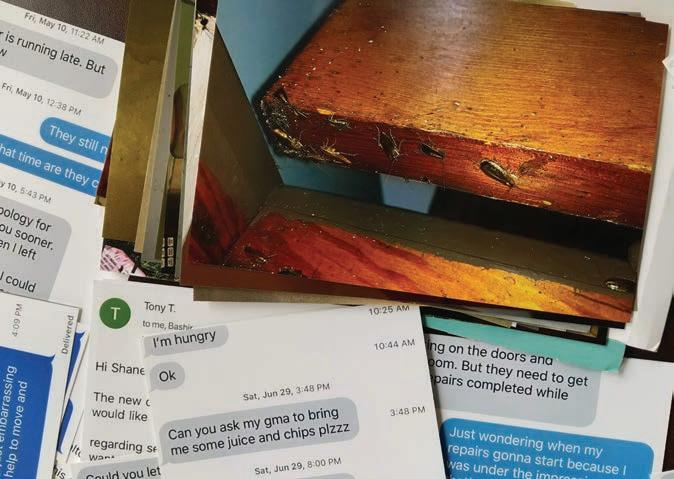 @mdoukmas
@mdoukmas



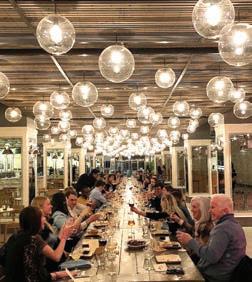

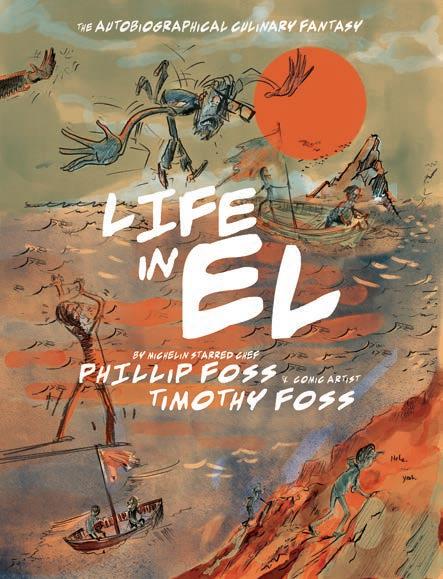
The restless innovator and Michelin-starred chef bares his soul in a new graphic novel.
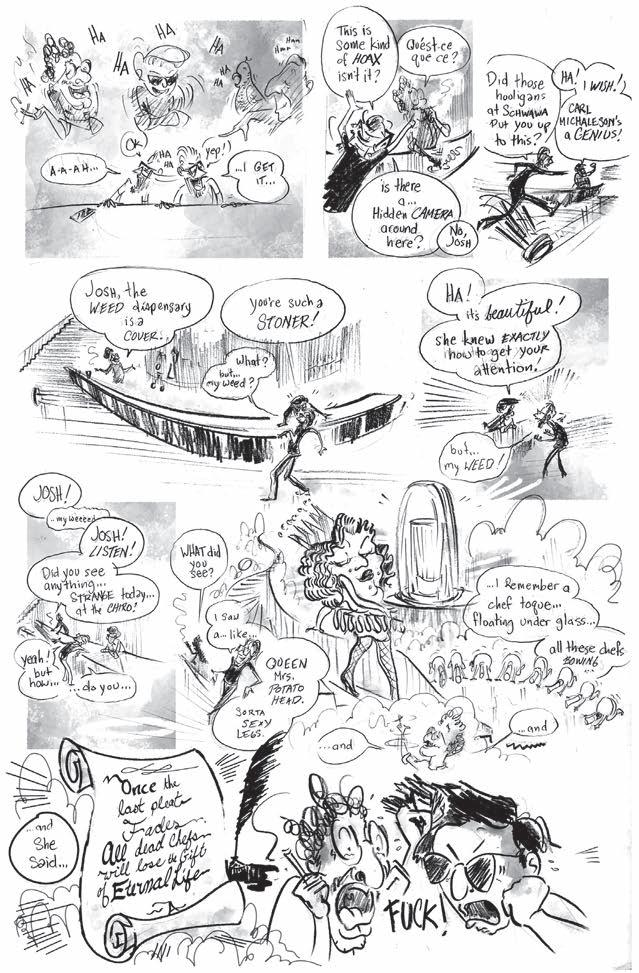 By MIKE SULA
By MIKE SULA
Phillip Foss has never had much of an internal censor. A gentler way of putting it is that he’s always worn his heart on his sleeve. The chef arrived in Chicago in 2007, taking the top job at Lockwood, the Palmer House’s fine-dining restaurant, during a time when chefs had become public figures rather than faceless, nameless galley drudges. Foss also launched the Pickled Tongue, one of the first and most consistent chef blogs, and was a prolific Twitter scamp. In fact, it was an attempt to broker peace between two battling chefs that got him canned from Lockwood three years later when
he tweeted: “Why can’t we all just smoke a bong?”
That didn’t shut him up. He went on to narrate, with equal irreverence, the saga of opening and running his Meatyballs food truck—the double entendre a standard trick of his trade—as well as the opening and early years of his chef-driven prix fixe restaurant, El Ideas. But with growing acclaim for the last, he seemed to hush up. Seven single Michelin stars later—the first in 2013, the latest September’s for 2020—he rarely pops up on social media anymore, an absence that has camouflaged the dramas of divorce, arthritis, anger issues,








continued from 11
and an employee theft that almost buried El Ideas.

“I ran the restaurant like it was anarchy,” says Foss. “I wasn’t at a place where I wanted to lead. It ended up backfiring.”



Foss always had literary ambitions—I’ve read chapters of an unfinished memoir—but over the last three years he, along with his cousin, illustrator Tim Foss, have been working on a graphic novel, titled Life in El, that’s a fictionalized hallucination of the chef’s existential angst.
The opening panels depict off-duty chef “Josh” waking his young daughters with the intoxicating aroma of thousands of dollars’ worth of white tru es—much to their disgust and his cost-conscious wife’s disapproval. From there a trip to the chiropractor elicits a vision of a giant anthropomorphic tru e goddess (“All chefs worship tru es”), and then a longer, lysergic trip to the neighborhood cannabis dispensary, where Foss encounters the ghosts of his dead heroes—partial stand-ins for Charlie Trotter and nouvelle cuisine chef Jean-Louis Palladin.
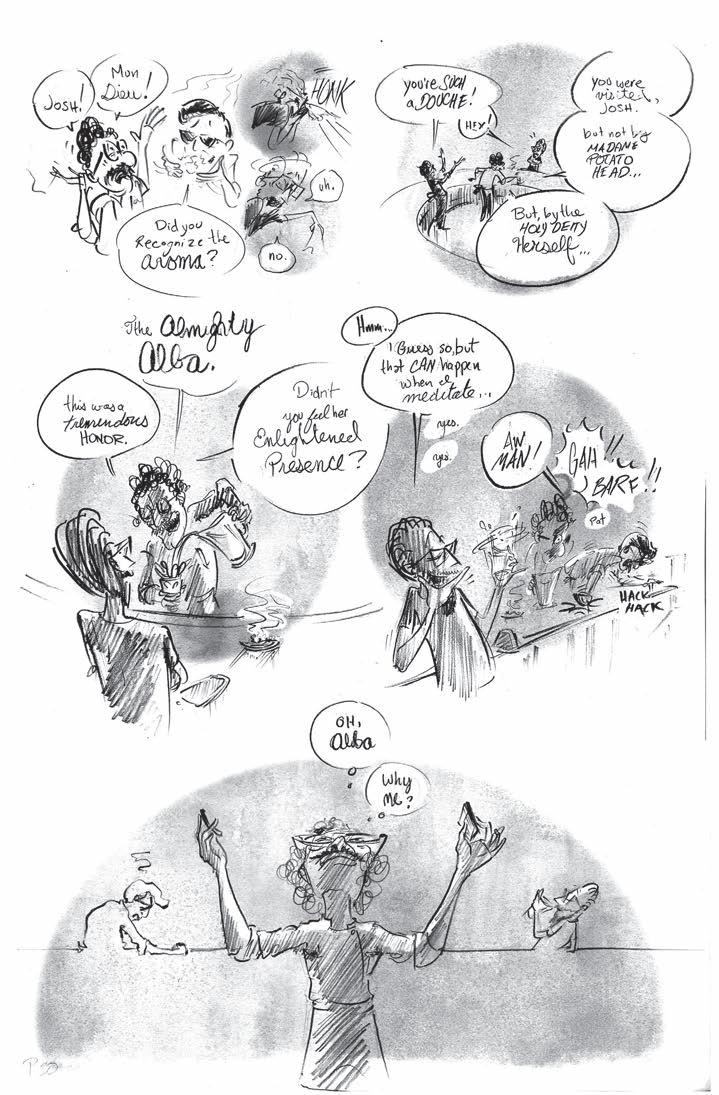
So what’s that all about?

Basically, the Michelin man made him crazy.
“Once I got a Michelin star, I wanted two,” Foss told me. “And the first year we didn’t get two, I was devastated. This whole thing has been a long process of learning to be OK with what we receive and trying to put into perspective the importance of awards and accolades and try to figure a way to not use them as a measuring stick.
“I guess the reason I became a chef in the first place is because I didn’t feel accepted.
Cooking food filled me up with a sense of acceptance, but also in the process I learned some really bad habits to escape my anger.”
Or to put it another way, from an early preface:
“When guests recall their meals with us at EL, they likely begin by speaking of some memorable dishes, the overall vibe, or close interaction with the culinary team. Unless there was some serious digestive issue, no-
body ever recalls anything about the crap they took afterwards. But lo and behold, no matter how much effort went into making the food beautiful for your eyes and delicious for your mouth, every morsel we make winds up as a nondescript, ugly brown mass that meets a most inglorious ending we’d rather not even think about. There’s a duality to all beautiful
art for sure, but I don’t think any is consumed or decomposed faster than in the culinary art. In many ways, this story is the decomposition of my ego . . . ”
Life in El goes on sale next week at elideas. com or at the restaurant. v
@MikeSulamiddle of a move, driving back from one place to the next, cleaning out everything,” one of the women says. “[It] kept me sane.”
Listeners are, as hosts can attest, extremely committed. Bingeing on television is an indulgence; bingeing on podcasts is the default. “Listeners tend to be pretty savvy,” says Podcast: The Ride cohost Jason Sheridan. “It’s like dominoes. Once you start listening to a couple podcasts, it’s very easy to just start subscribing to a bunch of others.” And data backs that up. In a Westwood One Podcast Network & Audio Insights study released over the summer, “power listeners,” who listen to more than five hours a week, make up the bulk of weekly listeners. And that’s to say nothing of the heaviest consumers, who can casually blow through a full work day plus commutes each way, earbuds in.

Part hangout, part celebration, part theater of the mind, live podcast recordings are a performance medium all their own.
By DAN JAKESSometime next month, Action Boyz podcast subscribers will listen to comedians Jon Gabrus, Ben Rodgers, and Ryan Stanger give a warmly received, nearly three-hour playby-play breakdown of the 1985 Chuck Norris cop flick Code of Silence to a packed Chicago ballroom. And when they hear those three improvisers and friends perform a tsunami of inspired ri s, impressions, and inside jokes, in all likelihood, those subscribers will be listening alone.
That is, of course, how podcasts normally work. Solitary and social at the same time, they’re a sort of kryptonite to loneliness, a form of entertainment tailor-made for commutes, workouts, errands, zone-out tasks—all of the times when it’s nice to be alone, but not alone alone. To the uninitiated, everything about paying for and even traveling great distances to a live podcast recording might seem counterintuitive. After all, it’s an event where audiences cannot fold laundry or cook dinner
or roll joints, an event from which cleanly edited, mostly real-time verbatim audio will be available online for cheap or even for free in just a few days or weeks.
But podcast recordings somehow just work as an art form in a way that is di erent from the improv, stand-up, and radio shows that precede and inspire them. And there’s a strong case to be made for them being one of the more noteworthy new artistic mediums to crop up in the last generation. If that sounds hyperbolic, consider, for example, Chicago Improv Productions’ annual Chicago Podcast Festival.
On a recent Saturday night at Lakeview’s Chicago Theater Works, a young man in a Japanese Terminator T-shirt walks up and down the aisles handing out green plastic Saint Patrick’s Day hats, a sight-gag reference to a previous Action Boyz episode commenting on The Fugitive. “This was a $90 joke,” he says, holding up the hats he brought with him from Portland to celebrate and take part in the
show’s first live episode. He took up listening to the show to fill the extra time on his hands proceeding a breakup earlier in the year—and it’s a recurring theme in shows’ mailbag segments. Podcasts have a strange capacity to make emotional funks and tedium bearable in ways that other audio mediums can’t.
Over at the bar, someone has left out a cardboard box of red buttons with the words “janitor” and “kisses for Stanger” emblazoned on them, nods to recurring jokes about the show’s listenership (“Who is cleaning all the middle schools?!” jokes Gabrus at the top of the show) and fan solidarity with the lovingly razzed cohost.
And in the lobby, where Podcast: The Ride fans are doing a meet and greet, two young women—one in a homemade “Jason for [Disneyland] Mayor” shirt—sell me on the entertainment value of the show’s 19-part miniseries exploring Universal Studios Hollywood’s oft-mocked CityWalk shopping complex. “The CityWalk Saga came out while I was in the
“They’re completionists,” Gabrus says. “People keep adding to their pull list like at a comic shop. If these people are doing it passively, they can fill six to ten hours a day of listening.” It’s that passive aspect that presents a unique challenge for some shows and a special creative boon for others when they take it out of the studio and put it in onstage. “People are going to start to realize, ‘Oh yeah, I drive while I listen to these,’” Rodgers jokes.
For Matt Besser, a founding member of the Upright Citizens Brigade who now hosts Improv4humans, putting his ASSSCAT -inspired podcast in front of a live audience—like the one at the Apollo in Lincoln Park the night before—is something of a homecoming and return to form for the show. (ASSSCAT is the UCB’s signature improv show, in which an audience suggestion inspires a story, which is then the basis for long-form improv.) The more complicated challenge for Besser came when he first launched the series, which took a comedy club performance format into a studio with microphones.
“You don’t need an audience,” Besser says. “I didn’t miss that so much, or I got used to that right away. It was more that ‘theater of the mind’ that was a tool to hone. I’d say it took like a year.” The breakthrough came when Besser fell back on the format he had created with Del Close in Chicago decades before called “the Movie.” Instead of relying on body work and dialogue to establish action and settings, “the Movie” encourages performers to get poetic and introduce absurdist and impossible imagery by cutting into scenes with script-style stage directions.
“And I guess when we reverse engineer it to go back to the stage, it’s funny, because I’m
from
basically just doing ASSSCAT in chairs,” Besser says. “But yet, I am still doing that ‘Movie’ format that I told you about when we’re sitting in those chairs that I wouldn’t necessarily do in ASSSCAT.”
Seeking out those types of shows that take on new qualities when they’re in front of an audience is an important part of the festival curation process, says CPF coproducer Kelly Opalko. “It’s difficult to translate podcasts with lots of postproduction to the stage. For example, [some shows] have so much editing, and the story is conveyed through the background music and sound e ects.”
It can also present an interesting catch22 for performers that encourages them to step out of their studio-based comfort zone. “The one trap that I think a lot of shows get caught in [for] their live shows is they try to do it exactly the same as in their normal shows,” says Please Make This cohost Spencer D. Blair. A regular episode with cohosts Laura Petro and Hobert Thompson involves conceptualizing and writing a spec screenplay to be performed by guest actors; for live shows, they condense about an hour’s worth of script pitching to about 20 minutes. “We were talking afterwards about how utterly exhausted we were.”
The added pressure of serving two audiences at once, each with a different optimal sense of pacing, forces hosts to get creative. “We try to have a little something special for the people who came out,” Sheridan says, “be it visuals or little videos or sight gags, something like that.” I don’t think I’ll ever forget the burn-downthe-roof excitement in the room following what is maybe the silliest commitment to a bit I’ve seen onstage. At the end of the Podcast: The Ride show, after the hosts announced a last-minute special guest flown in from LA, comedian and Doughboys cohost Nick Wiger hops onstage to “review” the parking complex at Woodfield Mall. “It’s good,” he says, to the sort of rapturous celebration normally reserved for World Series wins—then walks away.
It’s a joke with a reception that gets at the weird of what makes podcasts so satisfying and special. And to experience that in a crowd of like-minded fans is just something you can’t download.
@DanEJakes LITSocial worker Jonathan Foiles has written about Chicago’s fractured mental health system before. In a January 2018 report for Belt Magazine on the current state of the city’s mental health, he included an intimate story about a client named Anthony who’d lost his son to gun violence on the city’s west side. Using Anthony as an example, Foiles addressed the inadequacy of the city’s mental health system in treating similar clients. That story, however, was just grazing the surface.


Now Foiles, who works at Mount Sinai Hospital in Douglas Park, is digging deeper. In his book, This City Is Killing Me: Community Trauma and Toxic Stress in Urban America , published by Belt Publishing, he seeks to highlight how larger traumas within a community—things like unemployment, poverty, lack of a ordable housing, violence—as well as historical factors (Jim Crow laws, redlining, displacement) can have a toxic impact that makes it harder for people within those neighborhoods to thrive.
These issues are covered regularly in the media. Gun violence on the south side, for example, is frequently reported on, with outlets like the Chicago Sun-Times publishing weekly articles on how many shootings or killings occurred over the weekend. But Foiles says the mental impact of these traumatic events remains incomprehensible beyond numbers.
In his book, Foiles puts faces to these issues. “As humans, we thrive on stories,” he says. “So to really illustrate how policy in Chicago affects all people, it’s important to look beyond statistics.”
This City Is Killing Me highlights five of Foiles’s clients’ stories (their names and any
identifying details have been changed for confidentiality), all with di erent experiences that address flaws within Chicago’s public systems, including Illinois’s Department of Child and Family Services (DCFS), the Chicago Housing Authority, and Chicago Public Schools.
Jaqueline, for example, is a transgender woman of color diagnosed with borderline personality disorder. Her life was put at risk when in 2012 Rahm Emanuel shut down the mental health clinic she was attending, along with another five throughout the city. Other patients include Frida, a traumatized child turned traumatized mother whose children were taken away by DCFS, and Robert, a boy who endured severe trauma in the Cabrini-Green projects and then created a narrative for himself in which he believes he’s an African prince in exile to cope with reality. Foiles also tells the story of David, who failed out of selective enrollment high schools and lived impoverished among his textbooks, and Anthony, the subject of the Belt Magazine story that inspired the book.
Despite undergoing individual treatment with Foiles, these patients remained in a
cycle of depression and toxic stress because they lived in neighborhoods that are plagued by violence; had few supportive community resources such as after-school tutoring programs, affordable housing, and workplace development programs; and regularly experienced chronic disinvestment from the city.
“I can do my best work as a therapist to help someone improve,” writes Foiles in the book’s introduction. “But there is only so much that can be accomplished in individual therapy before we run up against the structures that continue to perpetuate su ering.”
Even if resources like workplace development programs are created, Foiles says, they are not the solution. These programs certainly help, but the issue remains rooted in systematic disinvestment, meaning there just aren’t enough jobs located within these neighborhoods that pay a living wage. Then there’s the issue of employers not hiring people who were once incarcerated which, again, continues to uphold this cycle of poverty and mass incarceration.
“We need to think bigger to create a framework that addresses these issues and how they continue to a ect people and communities of color,” he says.
Foiles is aware that fixing the system won’t be easy. His book is not an attempt to solve any of these issues, nor is it an e ort to make you feel sorry for his clients. “Rather, I want you to see them,” he writes, “to be forced to confront the impact that policy decisions have upon the lives of our city’s poorest residents.” v
@marndel7Jonathan Foiles’s new book, This City is Killing Me, explores how systematic forces contribute to mental health issues in Chicago.
R THIS CITY IS KILLING ME: COMMUNITY TRAUMA AND TOXIC STRESS IN URBAN AMERICA
CHASING A GHOST AND PRIVATE: WEAR A MASK WHEN YOU TALK TO ME Chasing a Ghost , Thu 10/31, 6 PM, and Fri 11/1-Sat 11/2, 8 PM, Chicago Stock Exchange Trading Room at the Art Institute of Chicago, 230 S. Columbus, 312 443 3600, sales.artic.edu, $10 members and students, $15 nonmembers. Sold out. Private: Wear a Mask When You Talk to Me, Sun 11/3, 6 PM, Cathedral Hall at the University Club of Chicago, 76 E. Monroe, https://tinyurl.com/ y4h455 pp, $10
DANCEIn Alexandra Bachzetsis’s Chasing a Ghost, relics of a powerful past form the backdrop for dances about exchangeability.
 By IRENE HSIAO
By IRENE HSIAO
On the northeasternmost edge of the Art Institute of Chicago, where Columbus meets Monroe, stands an arch in a small plot of land, fenced in with tall grass and dead flowers. Shorter than the glass-and-aluminum facade of the Modern Wing, it hovers over nothing and allows no roads through it. Viewed from
the north, it is blank limestone; from the south, terra-cotta dense with ornate detail. “Chicago Stock Exchange Building,” it announces, more like a tombstone than an entryway. “1893.”
Once this arch graced the LaSalle ingress to Adler and Sullivan’s celebrated edifice, considered by critics to be one of the masterpieces of modernist architecture by skyscraper pi-
oneer Louis Sullivan. Despite frantic bids for its preservation, the Chicago Stock Exchange building was demolished in 1972, leaving only fragments—and bones: photographer Richard Nickel perished beneath the unstable structure as he attempted to retrieve historic ornaments. Nickel’s body was not found for 26 days; his unfinished book on Sullivan was published 38 years later as The Complete Architecture of Adler and Sullivan.
In addition to the arch and Nickel’s pictures, relics from the Stock Exchange—mail slots, panels, kickplates, an elevator grille—are scattered about the Art Institute. Most strikingly, the two-story-high Trading Room, with its elaborate polychrome stencils, stained glass skylights, brass sconces, and faux marble pillars, was reconstructed and incorporated in its entirety into the Rublo Building of the museum in 1977.
Once a hub of finance where shouting men set the national price of meat, the room now stands quiet and empty, barring occasional use for “dinner, entertainment, and amusement” at wedding receptions and the like, functionally oscillating between an artifact to be examined and a setting for social events, sometimes a work of art treasured for its past, sometimes a backdrop to the present day.
“The theme of my piece is the uncanny—the strange discomfort we have with things we recognize but no longer know,” says SwissGreek choreographer Alexandra Bachzetsis about Chasing a Ghost, commissioned by the Art Institute as part of its new performance series “Iterations,” curated by Hendrik Folkerts. “The Stock Exchange Room calls for that through its aesthetics, its colors, its history.”
To consider the uncanny through the body, Bachzetsis has created an evening of duets premised on exchange, producing a succession of doubles and doppelgangers. “Everybody has a duet with everybody, more or less. You have a di erent story with every person you meet or every situation you’re in. [During this process], how do you shape identity? What is transmitted or inherited? There is always an uncanny aspect connected to exchanging someone for someone else. I don’t believe people are exchangeable, but this is—brutal-
continued from 15
ly—what happens to all of us, all the time. It’s the basis of all heartache and all impossible love, as well as all reality.”
Like the series title, the rendition of Chasing a Ghost that premieres this week (performances are already sold out) is just one of many iterations—after which the work tours to other cities and other spaces in Canada, Luxembourg, Germany, and beyond. Bachzetsis anticipates adaptation.


“It’s an entirely different experience to enter a black box, a white cube, an opera, a stock exchange room, or an industrial hall,”
she says. “These are interesting problems for me to solve, how to relate the work into the history of each space.”


For three days in Chicago, the Trading Room transforms into a theater for a performance of exchange. Then the performance trades places, once again making the exchanged room an Exchange Room. As an encore, Bachzetsis will perform her 2014 solo Private: Wear a Mask When You Talk To Me, on the duality of identity, before she vanishes from our midst. How uncanny. v
 @IreneCHsiao
@IreneCHsiao
Jimmy Carrane first made a name for himself 28 years ago when he premiered his solo “intimate evening,” I’m 27, I Still Live at Home, and I Sell O ce Supplies at the Annoyance. Now in his 50s, Carrane is still doing solo shows. His latest, World’s Greatest Dad(?) , premiered this past June at Judy’s Beat Lounge at Piper’s Alley. Beginning this weekend, it’s being revived Saturday nights in the same location. We spent a few minutes talking to Carrane about his life and career— and his new show.
I am wondering, your last solo show, Living in a Dwarf’s House , was 18 years ago. What made you decide to do a one-person show now, after all these years?

I went through a lot of changes since Living in a Dwarf’s House . I got into therapy, and that was huge. And that led to meeting Lauren, getting married, and getting a condo, and becoming a father at 52. I thought I would never be happy because I would never be famous. And then I met Lauren. And I still had an obsession with fame. And one day Lauren said to me, “You have a great relationship with me, and all you care about is being famous. Don’t I matter for you?” I said, “I guess so.”
Fame. It’s hard. A lot of the people we knew in the 90s are very famous people now. Yes, the comedy scene in the 90s—it seemed like one in four people was becoming famous, or became famous.
11/2-11/30

: Sat 7: 30 PM, Judy’s Beat Lounge at the Second City, 230 W. North, 312 337 3992 , secondcity.com, $20, $15 students, $10 Second City Training Center students.

And you knew a lot of them.
Dave Koechner [who later was in the Anchorman films and The Office ] was a roommate of mine. Rachel Dratch was in Jazz Freddy [a long-running hit improv show] with me, and she was also in a show called Grambinus with me. I was in a show called Ayn Rand Gives Me a Boner with Andy Richter, and he was also in [the improv group] the Comedy Underground [with me]. Chris Farley and I took classes at the ImprovOlympic [now called iO]. Mike Myers would sit in on our Harold team at iO, Stephen Colbert and I did an industrial together, where we played Siskel and Ebert. Guess which one of us played Ebert?
Compared to them, yes. I was in Chicago. They were moving to New York and LA. Some of them were going to write for Conan and Saturday Night Live . They were becoming famous; what was I doing wrong? I did feel abandoned. I felt like that guy in college who was still at the party when everyone had gone. I felt like every year I was held back a year.
Your first solo show, I’m 27, I Still Live at Home, and I Sell Office Supplies , was a big hit.
The early 90s. It was so magical, at that time, being at the Annoyance. It was like lightning striking again and again.

My major influence was Del Close. He believed in truth in comedy. I was fascinated by that. I had this idea of doing a one-man show. Just go out onstage and tell the truth about my life.
That you still lived at home in your late 20s and had a job you hated.
I didn’t know it at the time, but moving back home was part of a trend. And audiences really loved it. And critics. I didn’t think I got one bad review. I thought it was all happening for me. The show was Friday and Saturday nights. And it was such a fun show. It ran for a year and a half—and I closed the show.
My therapist told me he thought it was because I couldn’t take in the joy and success. It was hard after the show closed. I mean, I closed that show and at the same time Jazz Freddy closed on the same frigging night.
You didn’t go on to Second City?
I wasn’t in the Second City Touring Company. I was not part of Lois Kaz (a long-form improv show Second City created that featured many of the performers from Jazz Freddy).
The saddest thing that ever happened to me happened around that time. They asked me to audition for Saturday Night Live. I was supposed to go out to New York; I was supposed to do three characters, and three impressions—and I was scared—and I told my agent I don’t do sketch comedy. And I didn’t do it.
Like the character in the movie Don’t Think Twice . [In the movie someone is invited to audition for an SNL -like show, but then flakes out.]
Yes.


I hit this period where I was stuck in my life.
I was around 40. I hadn’t been in a relationship in 14 years. I didn’t have a life to talk about. I was getting more and more unhappy. I decided, I am going to try group therapy. And it turned out my improv background really helped with group. Improv gives you the tools to play along and think on your feet.
And improv teaches you that you can’t control what people will say.
Then you met someone, and married, and had your daughter.
Yes, having Betsy was huge. And then I came to this place where when I asked myself, “Let’s see if I can repeat what I did in I’m 27.” I had all this stuff happen the year that my dad died. Crazy stuff that happened at the funeral. [In the show Carrane recounts how an encounter with his siblings escalated into an encounter with the police.] There was crazy stuff on the plane. [Carrane was accused of being a terrorist.] And my reaction when Betsy came out. [Carrane was with his wife at Betsy’s birth.] I thought, “I have something to say now.” I wanted to see if I could relive some of the magic of I’m 27.
I mean, I am not trying to re-create that show. This show is different. I am different. I mean, there is a little bit of me being shlubby, and a little bit of me being a loser. I don’t want to disappoint my fans. But this show is about where I am now. v
The young creators of this new musical drew on their own experiences.
By CATEY SULLIVANMental illness as woman: It’s a trope that keeps on giving. From Blanche DuBois ( A Streetcar Named Desire) to Bertha Mason ( Jane Eyre ) to Norma Desmond (Sunset Boulevard) and beyond, writers have used female characters to embody the myriad manifestations of mangled synapses and misfiring neurotransmitters.
With their new musical Tru , David Gosz and Leo Fotos add a new one to the pantheon. Born six years ago when both men were teenagers struggling, Tru follows a young teacher wrestling with several mental health issues personified by Her, a young woman in a slip who repeatedly attempts to seduce him into cocooned isolation. Her tries to keep Truman from going to work, meeting friends and—as depression does with such cruel efficacy— from getting out of bed in the first place.
Gosz, 23, and Fotos, 24, grew up in Western Springs and Downers Grove, respectively. Both are candid about their own mental health struggles, and how they informed Tru
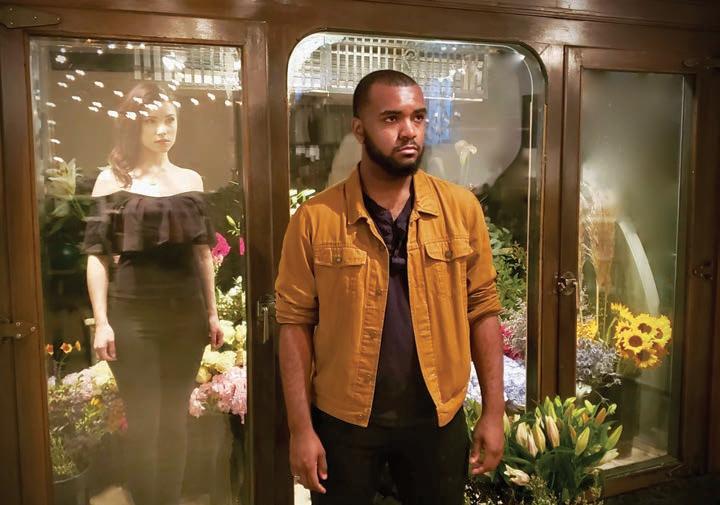
“It’s like an object that weighs me down,” Gosz says of the panic and anxiety disorders he lives with. “It’s su ocating. Having a panic attack is like someone sitting on my chest with their hands around my throat.”
For Fotos, anxiety issues escalated after he graduated from Downers Grove North High School and was accepted at Boston’s ultracompetitive, highly prestigious Berklee College of Music. “It was everything I’d ever wanted. I was so excited—like, now I’m going to learn how to actually write this musical. But my anxiety got so bad I ended up leaving after five weeks,” Fotos says.
That didn’t stop the creation process for Tru , which continued while Gosz earned his BA in economics from the University of Chicago and Fotos launched a career teaching piano and guitar. Like Fotos, Truman is a teacher. Like Gosz, Truman experiences anxiety that feels like a strangulation. As one of Truman’s lyrics puts it: “She’d rest her head atop my chest, then strangle me in her caress.”
So why make mental illness an under-
TRUThrough 11/24: Thu-Fri 7: 30 PM, Sat 2 and 7: 30 PM, Sun 2 PM; also Wed 10/30, 7 PM, Stage 773, 1225 W. Belmont, 773 327 5252 , stage773.com, $25 -$ 35
Tru LEO FOTOSdressed young woman? Why not a woman with clothes? Or a barely dressed man? Or a character at any other point on the gender spectrum? The answer lies in Truman’s character.
“Part of Truman’s story is that his mother had mental illness—which she called Him,” Gosz says, adding, “We didn’t want Tru’s experience to completely mirror his mother’s, but we wanted to show the connection. So we made Tru’s mental illness Her.”
“Truman and Her—it’s this toxic relationship,” Fotos notes. “For me, one of the really hard things about [mental illness] is that it isn’t always all bad. Like some toxic relationships aren’t completely bad. Mental illness can be seductive that way. I think that keeps some people going without treatment,” he says.
“Mental illness can be seductive and manipulative,” Gosz adds. “It’s so tempting when your bed is calling you, telling you the world won’t miss you if you never leave it.”
They sought out the National Alliance on Mental Illness for feedback on the musical. Kimberly Knake, executive director of NAMI’s metro suburban chapter, called the show “lyrical, impactful, and able to appeal to a larger audience.” When the show premiered alongside other new musicals at the 2018 Chicago Musical Theatre Festival, it was awarded “best music” and “best choreography” honors. Fotos and Gosz also solicited input from earlier staged readings.
“One of the things we heard was that no one will want to see a show that’s a downer. We’ve worked for six years to end on a hopeful note,” Fotos says.
“We want our audiences to leave with hope,” concurs Gosz. “First and foremost, we want them to leave thinking about their own experiences with mental illness. If they don’t have those experiences, we want them to leave with better understanding and compassion for people who do.” v
For resources and information dealing with mental illness, go to NAMI.org. Local resources are also available at the Chicago-based Rebecca’s Dream Foundation, rebeccasdream. org, and at the Depression and Bipolar Support Alliance at dbsalliance.org.
@CateySullivanNovember live performance heats up with world-premiere plays, works-in-progress dance pieces, and cured-meat comedy.
By KERRY REID, IRENE HSIAO & BRIANNA WELLENA travel agent has the “best/worst day” of her life and decides to end it all, leaving her colleagues at sea as they try to piece together the missing parts on a memorial blog. (Think Dear Evan Hansen without the songs.) Kate Tarker’s darkly comic play gets a world premiere with Rivendell Theatre Ensemble under Devon de Mayo’s direction, starring RTE artistic director Tara Mallen as the title character. Rivendell Theatre Ensemble, through 12/8, rivendelltheatre.org
Pygmalion goes pop in Tearrance Arvelle Chisholm’s sardonic comedy about a Canadian bubblegum star hoping to toughen up his image on a reality TV show, with the help of “bad boy” rappers Black and Alexand of Petty Young Goons. Lili-Anne Brown directs the midwest premiere. Jackalope Theatre, 11/5-12/21, jackalopetheatre.org
Githa Sowerby’s 1912 play was a hit, but it fell off the radar (perhaps in part because producers learned that “K.G. Sowerby”—the name under which the play was first presented—was a woman). Steppenwolf’s Francis Guinan plays the hard-as-nails owner of a glassworks in northern England who dominates his three children. Compared to Henrik Ibsen’s work in its time, Sowerby’s drama has enjoyed revivals in recent years. Mechelle Moe directs. TimeLine Theatre, 11/6-1/12, timelinetheatre.com
South African male choral group Ladysmith Black Mambazo and playwright Eric Simonson, whose collaborations for Steppenwolf reach all the way back to 1992’s The Song of Jacob Zulu, reunite for this world premiere, written by Simonson, who codirects
with Jonathan Berry. Set in Chicago and South Africa, the play combines blues with Zulu a cappella in a story about a Black South African woman who meets a white drummer from Chicago in the underworld. The two must return to the land of the living to correct a past mistake. Steppenwolf Theatre, 11/7-1/5, steppenwolf.org
Firebrand Theatre, the only musical theater company dedicated to expanding opportunities for womxn onand offstage, plays musical chairs in this staging of Ted Swindley’s show about legendary country crooner Cline and Louise, the superfan who meets her one memorable evening and becomes a pen pal for the rest of Cline’s too-short life. Firebrand artistic director Harmony France and Christina Hall—both of whom have played Patsy in the past—will alternate in the two roles during the run of the show, which features most of Cline’s bestknown hits. Den Theatre, 11/16-12/15, firebrandtheatre.org
NOVEMBER DANCE PICKS (IRENE HSIAO)
If one step in resisting climate change is honing the senses that grant us gratitude for what we experience and trust in what we witness, this evening of perfor-
mances at the Poetry Foundation promises a full range of training. Get a glimpse of Floe a work in progress by the Seldoms on the theme of water and its shi ing manifestations—glacier to ocean to flood. Hurricane Harvey victims and rescuers, marine scientists, and Moby-Dick are just some of the source materials for this sweeping work directed by Carrie Hanson, with text by Seth Bockley. Paired with Floe is a reading of LosingMiami,
bilingual poetry by Gabriel Ojeda-Sagué on the loss of Miami to the sea. “Start with sinking,” it begins. Thu 11/7, Poetry Foundation, poetryfoundation.org, F
RE|Dance Group, established to explore the long-distance collaboration between Chicago-based executive director Lucy Vurusic-Riner and Wisconsin-based artistic director Michael Estanich, celebrates ten years of making it work with the premiere of Vurusic-Riner’s What the Moon Pulls. This evening-length dance considers another form of long-distance influence: the moon on the tides and the corresponding push and pull of human relationships. Performed by eight dancers in the round, the work features original music by Mark Burns and uses lunar astrological charts to guide solos. Knowing RE|Dance, there will also be a little howling at the moon. Two other pieces from 2019, The Biggest Wail from the Bottom of My Heart and What Love Looks Like round out the bill. Thu-Sun 11/21-24, Filament Theatre, redancegroupchicago.org, $20-$30..
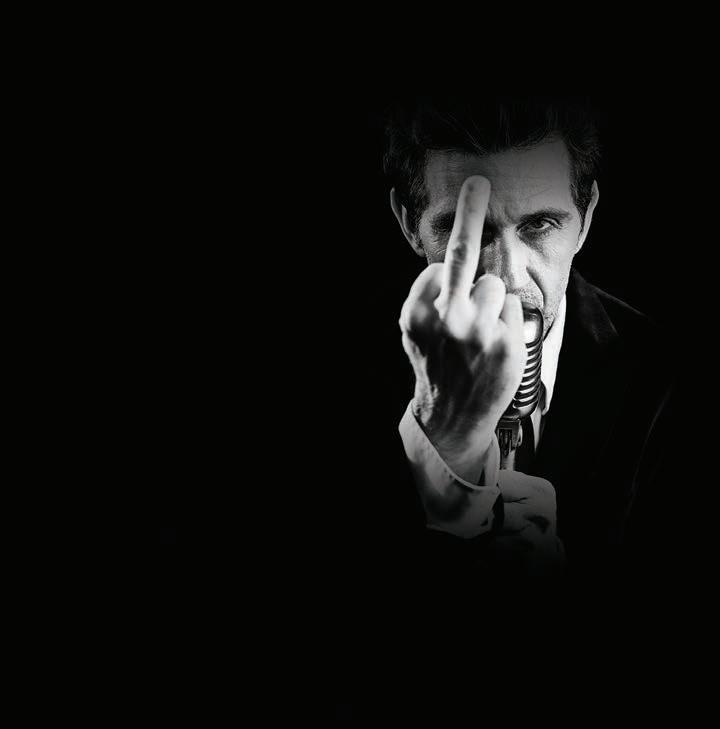
Comedy meets high school debate team in this monthly
show that sorts out the battles that really matter. Things like “Hugs vs. Drugs” and “Dr. Dre vs. Dr. Seuss.” This month Matt Riggs hosts with a lineup including Deanna Ortiz, Paula Skaggs, AJ Marroquin, and Dwayne Murphy Jr., just to name a few, arguing the merits of “My Birthday vs. Your Birthday,” “Vegan vs. Keto,” and more. Fri 11/1, 8 PM, North Bar, argumentsandgrievances.com, $10, $5 in advance.
It was only a matter of time before this show turned itself into a cured meat joke. This month the variety show that puts each edition into the hands of a different beloved performer will be taken over by Chicago sweetheart Eunji Kim. There will be comedians, storytellers, discussions of food, music, and an actual feast with a roasted pig. Sat 11/16, 7 PM, Cards Against Humanity Theater, 1551 W. Homer, facebook.com/curatedpresents, $20, $15 advance.
Everyone’s favorite comedian/musician extraordinaire Becca Brown is putting on a show! The night features comedy, music, drag, and fashion from Holmes, Devin Middleton, Derry Queen, Jerwin Gabriel Santiago, Allison Reese, John Love, and more. Tue 11/19, 8 PM, the Martin, 2515 W. North, themartinchicago.com, $10 suggested donation. v

A series of political engagement events as curated by
Center on Halsted Youth Program AlumniQueer Youth Halloween Party
October 31 | 4:30pm –7:30pm Center on Halsted 3656 N. Halsted St.
Chicago United for Equity Lincoln Yards Racial Equity Town Hall
November 2 | 11am – 2pm
Linda & Bill Gatz Boys & Girls Club at Lathrop Homes 2915 N. Leavitt St.
Indivisible Evanston Canvassing: FlipWisconsin 2020 with Indivisible Evanston
November 2 | 8am – 2pm Democratic Party of Evanston 747 Custer Ave. Evanston, IL 60202
Invisible A Play About the KKK, Followed bya Panel Discussion
November 2 | 7:30pm –10:30pm Stage 773 1225 W. Belmont Ave.
How Do You Stop a Tyrant likeTrump? Lessons for#TheResistance
November 3 | 2pm – 4pm
Conrad Sulzer Library 4455 N. Lincoln Library
Indivisible Lincoln Square ILS 2020 Election Committee Meeting
November 5 | 7pm –8:30pm
Conrad Sulzer Library 4455 N. Lincoln Ave.
Reproductive HealthAct Coalition
Reproductive HealthAct Celebration
November 6 | 6pm – 8pm Savemore Lounge 4060 N. Lincoln Ave.
YWCA Lake County Community Organizing 101
November 6 | 6pm – 8pm
Waukegan Public Library 128 N. County St Waukegan, IL 60085
Chicago Foundationfor Women

Supermajority: Al-JenPoo, Alicia Garza, & Cecile Richards
November 8 | 7:30pm –8:50pm
Harold Washington Cultural Center 4701 S. King Drive
2019 Young FeministConference November 9 | 9am – 1pm Motorola Mobility LLC 222 W. Merchandise Mart Plaza 19th Floor
“The 78” Racial EquityTown Hall Session 2 November 9 | 11am – 2pm Benito Juarez Community Academy 1450 W. Cermak Rd
She Votes Illinois! Get Out The Vote November 12 & 14 | 12:30pm – 2pm Roosevelt University
430 S. Michigan Ave. Preserving Chicago’s Middle Neighborhoods
November 15 | 8:30am –
1pm
Federal Reserve Bank of Chicago 230 S Lasalle St.
Pre-2020 Happy Hour!
November 15 | 5:30pm –8pm Randolph Tavern 188 W. Randolph Tavern
KINETIC’s 5th Annual Immigrant & Refugee Youth Art Gallery November 15 | 6pm – 8pm Hairpin Arts Center 2810 N. Milwaukee Ave. 2nd Flr
She Votes Families! November 17| 10:30am –11:30am Aubergine Chicago 3530 W. Armitage Ave

November 17 | 2pm – 5pm U.E. Hall 37 S. Ashalnd Ave.
YWCA Evanston/ North Shore A Lethal Relationship:Gun Violence and Domestic Violence November 20 Registration Check-in: 8:30am Program: 9am-3pm
The Conspirators blend commedia and police brutality in their Dario Fo update.
Wm. Bullion directs Sid Feldman’s update of a 1970 Dario Fo comedy about a chameleon-like character who exposes police hypocrisy and corruption. By changing the setting from 1960s Italy to present-day Chicago and the victim from an anarchist to a Black motorist, Feldman and company are able to lob dozens of topical zingers, and the subject couldn’t be more relevant. But is it funny?
The answer will depend on how you like your laughs. The Conspirators traffic in a breathless commedia dell’arte style. Think greasepaint and nonstop shtick. Anthony Hinderman plays it appropriately broad as the shape-shi ing actor making fools of a station full of bumbling cops. But the standouts are Nicole Frydman as the Chief of Police and Kate Booth as Detective Bertowski. Playing caricatures of retrograde male Chicago cops, both women accentuate the absurdity while lending a surprising and welcome vulnerability beneath the bluster.
The thing about the Keystone Kops/Looney Tunes approach is that it benefits from brevity. At more than two hours (including a momentum-killing intermission), this play would benefit from some trimming. The very serious and ongoing issue of police brutality is a worthy subject and there’s no doubt of this company’s sincerity, but a er being pummeled by a staccato attack made up of human ugliness, I longed for a reprieve.
—DMITRY SAMAROV ACCIDENTAL DEATH OF A BLACK MOTORIST Through 11/23: Thu-Sat 8 PM, Athenaeum Theatre, 2936 N. Southport, 773-9356875, conspirewithus.org, $23, $15 students.
Prop Thtr’s devised play about the Holocaust focuses on resistance, bravery, and survival.
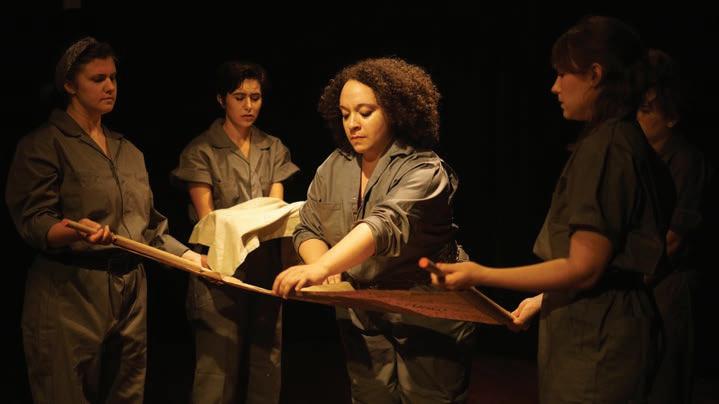
Anna Gelman directs the world premiere of I Am Going to Die Alone and I Am Not Afraid, an ensemble-devised
play about the Holocaust that feels hauntingly contemporary. A mostly bare stage decorated with lines full of white and beige clothing hanging near the ra ers—le as if forgotten by a whole neighborhood suddenly vanished—hosts a versatile group of six actors, who tell, sing, and dance tales of resistance, bravery, and survival. Based on firsthand accounts of the Holocaust, these brief scenes oscillate seamlessly from gallows humor to heartrending sorrow without ever feeling preachy or plodding.
Using flashlights, chalk floor drawings, and rudimentary props, this ensemble manages to bring a particular people’s suffering to life in a way that feels both universal and, sadly, entirely of the moment. A sequence in which stick-figure images of people have their eyes punctured, then spotlit by flashlights is an indelible evocation of the end of childhood innocence. Schoolchildren’s accounts of friends here one day, gone the next are gutting in their plainspoken pain.
In a time when so many societal forces are hell-bent on dividing us along tribal lines, this powerful piece of theater shows how sharing the tribulations of one people must give all people pause. The final scene tells the story of Prague’s Pinkas Synagogue; afflicted by floods for centuries, it now houses a memorial of 78,000 handwritten names of Czech victims of the Shoah. These names must be rewritten every few years as the waters wash them away. I can think of no better metaphor for the function of art—to remind us, as this play does, to keep the memory of the fallen fresh and remember the horror we’re all capable of. —DMITRY SAMAROV I AM GOING TO DIE ALONE AND I AM NOT AFRAID Through 12/6: Thu-Sat 8 PM; also Mon 11/18 and 12/2, 8 PM (industry); no shows Thu 11/28-Fri 11/29, Prop Thtr, 3502 N. Elston, 773-742-5420, propthtr. org, $20, $15 industry.
A solo show about Lenny Bruce doesn’t skimp on the performer’s failings.
In the painfully honest spirit of Lenny Bruce, let’s begin with a couple of blunt observations. The first is that the very issue Bruce fought and died for—free speech and the right to say anything—has devolved in recent years into a gleeful incivility in which haters, trolls, and
For more information of listed events please visit persistlist.org

MOBILIZE sponsored byMOBILIZE

fools feel they can say anything, hurt anybody, and then hide behind the First Amendment. Bruce cursed a lot onstage, as Ronnie Marmo makes clear in his well-written, well-performed one-man show, I’m Not a Comedian . . I’m Lenny Bruce, directed by Chicago theater legend Joe Mantegna. But Marmo also makes clear that Bruce had a heart—and a message that was the very antithesis of the one communicated in poison-filled tweets and gleeful bad-boy rants. The second is that Bruce’s comedy is very time bound, and much of his humor is more interesting as historical artifact than laugh-out-loud funny.
Still, there are worse things for a solo show to be than interesting. And Marmo’s 90-minute review of Bruce’s life and work keeps our attention from start to finish. Marmo has Bruce’s delivery—every pause and gesture—down cold. Even more impressive is how well Marmo succeeds in winning our sympathy. Bruce’s last years, encompassing myriad battles with authorities (including a famous trial for obscenity) and drug addiction, though the stuff of comedy legend, must have been a living hell. But Marmo also leaves us with the undeniable feeling that Bruce was a deeply flawed person, if clearly one of the best comic minds of his generation: a bad dad, a lousy lover, and a genius who may have needlessly squandered it all looking for a fix. —JACK HELBIG I’M NOT A COMEDIAN . . . I’M LENNY BRUCE
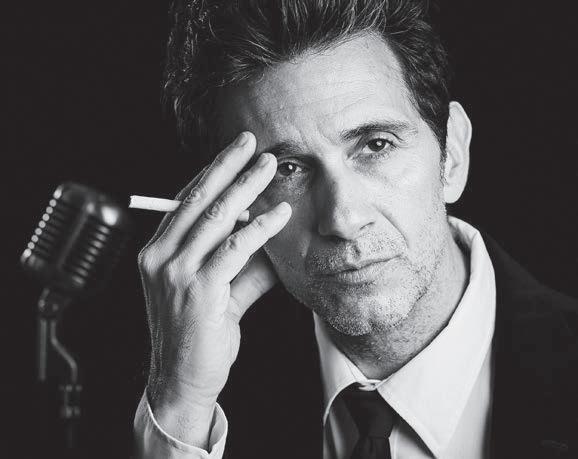
Through 12/1: Thu 7:30 PM, Fri 8 PM, Sat 3 and 8 PM, Sun 2 PM; also Wed 11/20, 7:30 PM; no performances Thu 11/14 and 11/28, Royal George Theatre, 1641 N. Halsted, 312-988-9000, lennybruceonstage. com, $69-$79.


R Speaking ill of the dead Silent Theatre Company runs its mouth in a new immersive piece.

Concentrate on the cookies. Practice your song. We won’t speak ill of Pastor Eddy at the poor man’s funeral. It doesn’t matter what unfinished business you and he had le when he died by falling off a ladder the other night. It doesn’t even matter whether you think he was pushed. Keep it to yourself. Only you can’t. Good Lord, this is going to be one of those messy funerals isn’t it? You hate to see it.
Mary and Pastor Ken are in the book lo , going full vindictive congregant on the widow, Alice, behind her back for never taking Eddy’s last name—Alice who, meanwhile, is downstairs, refusing quiche and possibly flirting with her tall, tawny, Burner-looking friend named
Max, who is somewhat mysteriously in town. (Do you, in fact, love to see it?) As audience members for Incomplete Conversations, we immerse, milling through the sanctuary, lucking into earfuls of what ranges from gossip to raw anguish along the way. (Unlike earlier shows, this Silent Theatre Company production, written and directed by Nell Voss in collaboration with Tonika Todorova and the ensemble, isn’t silent.) A sense of Pastor Eddy emerges as someone not so very well liked, rather a rude awakening for Eddy himself, who, doomed for a certain term to schmooze at his own going-away party, appears to rehash old arguments with Alice, Ken, and the others in a series of quietly devastating flashback scenes.
By the end of the night and the show’s grand finale, Eddy’s actual “service,” every secret is in the open. Faith, pride, and death’s mystery all enter the picture. What an astonishing play. —MAX MALLER INCOMPLETE CONVERSATIONS Through 11/23: Thu-Sat 7:30 PM, Tapestry Fellowship Church, 3824 W. Irving Park, silenttheatre.com, $20 or pay what you can.
Edgar Allan Poe’s horror fiction and horrific life fill Oak Park’s Cheney Mansion.
Staged in various rooms throughout Oak Park’s Cheney Mansion, David Rice’s clever and moving promenade-style show (directed by Skyler Schrempp), interweaves long passages from Edgar Allan Poe’s better-known writings (“The Raven,” “Annabel Lee,” “The Masque of the Red Death,” “The Tell-Tale Heart”) with original biographical material to create a portrait of a desperate, half-mad writer inspired by and deeply obsessed with his child bride and her tragic early death. (Virginia Clemm was only 13 when she married Poe, and only 24 when she died of TB.)
There may be few surprises in this show for those familiar with Poe’s life and work, but there are still plenty of delights. The universally high level of performance achieved by Schrempp’s ensemble brings out the best in Poe’s sometimes overwrought work. Christian Gray is especially sublime as Poe. Even when he’s declaiming poetry as well known as “The Bells,” he rings new sounds out of the familiar stanzas. Erica Bittner is similarly appealing as Virginia; her performance as someone dying of consumption is utterly free of melodrama or false sentimentality. Schrempp’s staging mines the brilliance of Rice’s original premise (earlier versions of this show were performed promenade
style at the Mayslake Peabody Mansion in Oak Brook). Having the audience move to a different room every ten minutes or so keeps the mind fresh, the eyes alert, and ears open to the production’s many new interpretations of old words. —JACK HELBIG THE MADNESS OF EDGAR ALLAN POE: A LOVE STORY Through 11/17: Thu-Fri 8 PM, Sat 1 PM, Sun 3 PM; also Thu 10/31, 5 PM, Cheney Mansion, 220 N. Euclid Ave., Oak Park, 708-300-9396, oakparkfestival.com, $35, $28 seniors, $15 students.
A new play about the use of the N-word relies on a faulty premise.
N at the Greenhouse Theater is based on a faulty premise: that a white actor would refuse to say the N-word in a play. Stage and screen are universally acknowledged as being “allowable” environments for this. However, this incident only serves as a MacGuffin for a clunky “both sides” thought experiment on liberal hypocrisy.
Stacie Doublin plays Mrs. Page, an older Black Republican forced by her son to accept a caretaker. Ryan Smetana plays Eddy, the naive young thespian charged with caring for this headstrong, eccentric woman. Doublin and Smetana embody the endearing odd couple well; Doublin expertly navigates the arc from crotchety to kind, and Smetana de ly makes the trek from youthful innocence to defeated adult. Director TaRon Patton finds some genuinely hilarious and touching moments.
Unfortunately, playwright David Alex’s script casts the actors as straw-men proxies for cliched social-media arguments. Eddy is cast as the obtuse mansplainer, droning on about why people shouldn’t be offended, and Mrs. Page is tasked with educating him in the form of sassy Black History zingers. Too much time is wasted on constitutional law and the long-gone history of the liberal days of the Republican Party, and not enough is spent on Mrs. Page’s life as a pariah in Black society. Actor Reginald Hemphill makes a short cameo as DeShawn, Eddy’s Black friend, a character whose perspective could have run deeper; as it is, he’s a mere foil for Eddy to realize that his experience as a white man is different than a Black man’s. A subplot involving Eddy’s director and the professional costs of integrity shows unrealized promise. However, the depiction of the struggle of being infantilized in old age is extremely thoughtful.
There are certainly two sides to every story, but N doesn’t have anything new to say about either side.
—SHERI FLANDERS N Through 11/17: Thu-Fri 7:30 PM, Sat 3 and 7:30 PM, Sun 3 PM, Greenhouse Theater Center, 2257 N. Lincoln, 773-404-7336, greenhousetheater.org, $25, $15 students, seniors, and industry.
Proxy examines true-life trauma in tunes.
Last week, Payton Leutner, the victim in the Wisconsin “Slender Man” attack in which two of her schoolmates stabbed her multiple times as tribute to a fictional
ghoul (one they believed to be real), spoke out for the first time since the horrific event. That’s serendipitous timing for Underscore Theatre Company’s new musical by composer Alexander Sage Oyen and book writer Austin Rega. In Proxy, Vanessa (Carisa Gonzalez) is 15 years out from the time her best friend, Veronica, or Ronnie (Tessa Dettman), plunged a knife into her torso a dozen times.

Since then, Vanessa has been staying far away from her Minnesota family—not even her father’s death from pancreatic cancer has brought her closer to her mother, Martha (Jenny Rudnick), and her slacker brother, Sean (an ingratiating Kyle Kite). She prefers dealing with her trauma on her own, which means she’s not really dealing with it at all.
That changes when she decides to help save the Internet publication where she works as a staff writer
with her on-again, off-again boyfriend, Doug (Michael Mejia), by going undercover at the mental institution where Ronnie now lives to interview her. Big story! Massive clicks!
It’s a tribute to Gonzalez and Dettman in particular that they make the scenes between the two women carry so much emotional weight, divvied up by measures of regret, confusion, rage, and a numb but palpable sense of compassion. There’s the nugget of a great question here: How do we forgive the worst thing that ever happened to us, and do we need to do that in order to fully live again?
Unfortunately, there’s a lot of narrative throat clearing in the first act before we get to the heart of that relationship, and some of the awkward transitions in Stephanie Rohr’s staging deplete the momentum as
Filmmaker
UCLA FESTIVAL OF PRESERVATION Nov.

LINDA RONSTADT:
Dennis
New
well. Yet there are enough solid interludes in Proxy to hope that the creative team will take—wait for it—another stab at the material. —KERRY REID PROXY Through 11/24: Fri-Sat 7:30 PM, Sun 4 PM, Mon 7:30 PM, the Understudy, 4609 N. Clark, underscoretheatre. org, $25.
Sugar in Our Wounds offers a hearttugging portrait of Black queer love in the Civil War era.
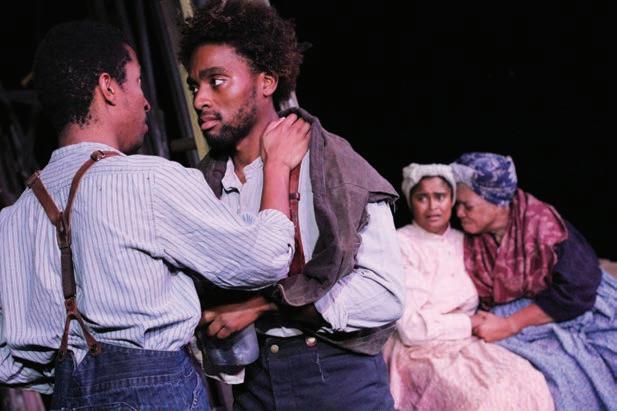
I try not to show any emotion when I attend plays as a critic and not just an audience member, but I couldn’t help but shed some tears during the Chicago premiere of Donja R. Love’s Sugar in Our Wounds a romantic drama about two enslaved Black men who find love and home in each other as the Civil War rages on. Produced by First Floor Theater and directed by Mikael Burke, the play is the first in a trilogy that explores the forgotten stories of Black queers, as their existence has been largely erased by history.
Beneath Joy Ahn’s beautifully decorated set featuring an intricately designed tree said to “stretch up to heaven,” we meet three slaves who have formed a family unit a er being torn from their families of origin: James (played with grace and vulnerability by Michael Turrentine), Aunt Mama (Renee Lockett), and Mattie (Ashley Crowe). When a stranger named Henry (Londen Shannon) walks into their shack, they take him in and teach him that in order to make it back to his family, he has to be smart about his movements. Soon, a romantic bond is formed between James and Henry, and the two find a happiness in each other that they have not felt since being ripped away from their first families
The script is full of poetic lines, especially within scenes shared by Henry and James, who say that their hearts sing the same song and that they feel closer to God when they’re with each other. While the play certainly tugs at heartstrings, I don’t think it says anything new about queer relationships in history but merely reminds us that their love has routinely ended in tragedy.
Nonetheless, Sugar in Our Wounds hurts so good that you can’t help but sympathize with our protagonists as they find love and then lose it—and as I looked around the audience a er the play ended, I saw I wasn’t the only one who’d succumbed to my tears. —MARISSA DE LA CERDA SUGAR IN OUR WOUNDS Through 11/23: Thu-Sat 7:30 PM, Sun 3 PM; also Mon 11/4
and 11/18, 7:30 PM (industry), Den Theatre, 1331 N. Milwaukee, 773-697-3830, firstfloortheater.com, $25-$35, $20 students.





Red Theater Chicago’s You Are Happy is creepy but sometimes compelling.
Jeremy wants a girlfriend more than anything, but can’t get one. So naturally, he hides in his sister Bridget’s closet with a rope, planning to end it all. He changes his mind at the last minute—and goes for the razor instead, just as Bridget opens the door. He survives, but Bridget (who is avowedly proud of her single status) decides (to quote Todd Rungren), “We Gotta Get You a Woman.”
So she basically tricks Chloe, a young woman she meets in a supermarket, into signing a contract agreeing to become Jeremy’s lover.

Does this sound vaguely incel and creepy to you? Well, Rébecca Déraspe’s You Are Happy (originally entitled Deux Ans dans Votre Vie—or Two Years of Your Life), now in a production with Red Theater Chicago, doesn’t spend much time making us feel comfortable with its premise—no more so than Elaine May did in Not Enough Rope, her 1964 one-act in which a depressed woman tries to borrow a noose from the man across the hall in a naked plea for attention.
Codirector Mary Kate Ashe, Brendan Connelly (who plays Jeremy), and Michelle Mary Schaefer (who plays Chloe) provide further layers to this dark little fable by translating Leanna Brodie’s English version into American Sign Language. (Bowie Foote, Sarah JK Shoemaker, and Elana Weiner-Kaplow provide spoken-word dialogue alongside Connelly, Schaefer, and Emily Turner’s Bridget, though Turner also speaks.)
Ashe and Aaron Sawyer’s staging is minimalist, which makes the heightened parallel play between the ASL and the voiced speech (not to mention supertitles) serve as commentary on the delusions of equality in coupledom. Whose “voice” is really being heard as conflicts arise? Connelly brings a little-boy-lost quality to Jeremy, but that can’t quite overcome (nor, I suspect, is it meant to) the character’s essentially manipulative nature. The rise of incel culture makes that impossible to ignore. But the cast deliver solid committed performances, o en with a deadpan demeanor that makes the story’s dark absurdism even clammier. —KERRY REID YOU ARE HAPPY Through 12/8: Thu-Sat 7:30 PM, Sun 3 PM, the Edge Off Broadway, 1133 W. Catalpa, redtheater.org, $10-$30. v
The revelation of dark secrets in narratives is o en anticlimactic, but not in this exquisite expressionist drama (1998) about a haunted woman who’s escaped slavery to live in dreamy yet nightmarish isolation with her daughter in Ohio. In a small but labyrinthine house racked by violent supernatural activity, Sethe (Oprah Winfrey) and Denver (Kimberly Elise) receive unexpected visitors whose motives are powerful and obscure. One is Paul D (Danny Glover), a long-lost family friend who tells Sethe things about the past she didn’t know. The other is a stranger (Thandie Newton) who competes with Denver for Sethe’s attention before the four learn too much about one another to continue living like a family. Using overwhelmingly potent performances, audacious static close-ups, assertive lighting, and a rigorous yet lyrical interweaving of events set in three different time frames, this terrifyingly beautiful movie blends metaphor and stark social commentary to achieve a spontaneous grace. —LISA ALSPECTOR 171 min. Part of the Cinema 53 series. Registration required. Thu 11/7, 6
A Black cop finds herself caught between her community and her fellow officers in the aptly named Black and Blue. Naomie Harris, best known for her Academy Award-nominated turn in 2016’s Moonlight, gives an excellent performance as Alicia, a rookie with only three weeks on her hometown police force when she captures corrupt cops shooting a young drug dealer on her body camera. With no one to turn to except a childhood friend (played with surprising sensitivity by Tyrese Gibson), Alicia must race back to the precinct with the footage while dodging local gang members and the dirty cops responsible for the murder. Deon Taylor’s film shines when it comes to action, with fast-paced fight sequences and impressive stunts that never stray into the sort of unrealistic depictions that other films in the genre rely on. However, the movie falters when pushed beyond its intriguing premise to a meaningful message. The film only half-heartedly explores the unique position of being African American, female, and a police officer in a time where every other news headline is a police shooting of an unarmed Black person. —NOËLLE D. LILLEY 108 min. Harper Theater, Lake Theatre
Kimberly Peirce’s first feature (1999), written with Andy Bienan, tells the disturbing story of Teena Brandon (Hilary Swank)—raped and murdered in late 1993 for impersonating a man—as harrowingly effective agitprop against sexual intolerance and hate crime. It’s a film with all the earmarks of earlier work by American independent producer Christine Vachon (Poison, Swoon, Safe, I Shot Andy Warhol, Go Fish). In some ways the story is about class as much as sexuality, and within this framework the actors do a fine job—especially Chloë Sevigny as Teena’s girlfriend Lana. —JONATHAN ROSENBAUM 118 min. Director Kimberly Peirce attends the 20th anniversary screening. Thu 11/7, 7 PM. Logan Center for the Arts
In advance of Linda Ronstadt’s 2019 Kennedy Center honor, the Mexican American singer is the subject of this documentary that explores her musical beginnings
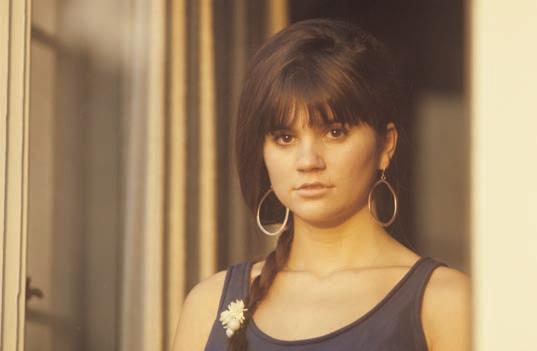
in Tucson, her rise out of LA’s folk-rock scene into international stardom, and her 2009 retirement following a diagnosis of Parkinson’s disease. As her friend and Trio collaborator Dolly Parton said, “Linda could literally sing anything,” and for over a half century, she did just that, applying her versatile vocal chops to rock ’n’ roll, folk, country, R&B, mariachi, jazz standards, musical theater, and other styles and finding success with practically every turn (she has 13 platinum albums to date). The film successfully paints Ronstadt as a whip-smart, boundary-breaking artist who champions traditionally marginalized voices in the industry and values music and loved ones over careerism and fame (it’s hard not to leave imagining she’d make a great BFF!). But it shies away from critically evaluating her accomplishments while portraying her as somewhat forgotten in today’s music scene, which seems a tad unfair, as there are plenty of contemporary country, folk-rock artists, and other musicians who could easily chime in on her lasting influence.

—JAMIE LUDWIG PG-13, 95 min. Glen Art Theatre
Why does it o en seem that filmmakers who perfect every last detail of their visual presentation can’t bother to put a fraction of that effort into storytelling or character development? Paradise Hills is an eye-pleasing dystopian drama about rebellious young women enduring treatment at a lush, fairy-tale island clinic-slash-spa run by an evil-queen-like matron (Milla Jovovich), and her staff of white-clad, modelesque manservants. The goal is to transform the patients into docile, idealized versions of themselves before they’re sent home to their families—essentially, The Stepford Wives if the women were made into fembots long before they said “I do.” Unfortunately, no amount of gorgeous costumes, impressive special effects, or decent performances (particularly from Jovovich, and supporting actors Awkwafina and Danielle MacDonald) can make up for the film’s tired narrative, one-dimensional characters, clumsy take on social politics, or any number of plot holes. Directed by Alice Waddington. —JAMIE LUDWIG 95 min. Gene Siskel Film Center
Mel Brooks scours the Star Wars saga for signs of comic life (1987), though the main parodistic targets here are the merchandising spin-offs that surround the series. Brooks seems genuinely exercised by the crassness of it all (a pot-and-kettle irritation, it seems to me), which makes the humor more irascible than usual (is that really possible?) but also a bit more personal: for once
he’s not the uncommitted jokester, and some things are evidently worthier game than others. The film’s low-tech styling is roughly the cardboard inversion of the cinematic machines it parodies, and Brooks seems less inclined than usual to push the overkill urges too far. Small compensations, I guess, but at least it’s not the total washout you’d expect. With Bill Pullman and John Candy (spaceniks on the side of light), Daphne Zuniga, Rick Moranis (a diminutive Darth Vader villain), and Brooks himself in a double role. —PAT GRAHAM PG, 96 min. 11/1-11/4, 11 PM. Logan
The 36th Chicago International Children’s Film Festival seeks to “set an internationally-recognized standard of excellence in film for children and youth.” For a full schedule visit festival.facets.org/schedule-2019. 11/211/10. Facets Cinematheque
Curated by filmmakers (and former Chicagoans) Alexander Steward and Lilli Carré, this two-program mini festival includes new work and selected retrospective titles. Filmmakers featured this year include Janie Geiser, Barbara Hammer, Allison Schulnik, Kevin Eskew, and Sebastian Buerkner. Steward and Carré attend the screenings. Sat 11/10, 1 and 3:30 PM (two different programs). Block Museum of Art
This touring showcase features clips from old VHS tapes that hosts Joe Pickett and Nick Prueher salvaged from garage sales and thri stores. This year’s finds include the 1988 Miss Junior America Wisconsin pageant, home movies taken at a Canadian hose factory, and rare footage from the 1982 dance show The Chicago Party 120 min. 11/1-11/2, 9:30 PM. Music Box v
CHI-ROCK NATION PRESENTS THE ELEMENTS: A CELEBRATION OF CHICAGO HIP-HOP With DJ Twelve Gage, DJ Pacman, DJ Vee 8, Murda Megz, DJ Pumpin Pete, DJ Jesse de la Peña, and more. Sat 11/2, 7 PM-2 AM, Community Art Center, 1213 W. 63 rd, $15 requested donation, $10 in advance, all ages
Almost three decades ago, Darrell “Artistic” Roberts decided he needed to document the history of Chicago hip-hop. He’d started breakdancing in 1982, and soon took up hip-hop’s other foundational elements: MCing, DJing, and gra ti writing. His love of gra ti blossomed in the mid- to late 80s, and at a citywide writers’ meeting in 1987, he met his future collaborator in this ambitious project, a gra ti artist named Fere (pronounced “fear”). By 1992, they’d both been involved in the local scene for about a decade, which made them veterans in a still-emerging movement. That year they sketched out an idea for a Chicago hip-hop history book.
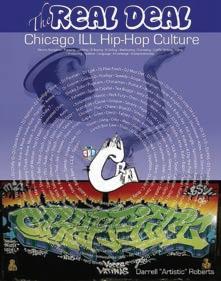

“We just started collecting photos, looking through there, like, ‘Oh, this would be a good picture to put in,’” Roberts says. “We started connecting the dots, and it just got bigger and bigger. It was like, ‘OK, it’s gonna cost us to do this book.’”
To raise funds for their project, they launched a magazine called Chicago Rocks in 1993. It was a way for Roberts to document the community month by month, a little at a time, which proved more manageable than the task of writing a single authoritative volume. At the time Roberts subscribed to The Source, the most influential magazine in hip-hop, and
By LEOR GALILDarrell “Artistic” Roberts of Chi-ROCK Nation has worked to document the culture he loves for more than three decades—and now he’s fi nally publishing a book.The cover of Roberts’s new book. The fi rst volume in the Real Deal series focuses on DJing.
its egregious blind spot with respect to the midwest helped motivate him. “They said if you can’t beat them, join them, but in this case we didn’t want to do neither one—we couldn’t beat them and we didn’t want to join them,” he says. “We just decided, ‘You know what, we gonna do our own thing.’”
Chicago Rocks was one of a handful of Chicago hip-hop publications to emerge in the 90s, including FlyPaper, Elevated, and Caught in the Middle Chicago Rocks lasted till 1998, and when Roberts closed it down, he put the book on hold as well. He chose to build up his family instead and removed himself from the scene until 2015, when he began reconnecting with old friends on Facebook. That’s when he got the idea to revisit the history project— though now he’d be going it alone. “I was like, ‘Wow, so nobody still has done anything in regards to Chicago hip-hop, in terms of a book or anything,’” Roberts says.
Four years later, Roberts is about to publish the first book in a four-part series called The Real Deal . Each volume will focus on a di erent element of hip-hop culture, and the first documents Chicago DJs. He celebrates its release Saturday, November 2, as part of the Elements, a celebration of Chicago hip-hop
hosted by the city’s oldest hip-hop community group, Chi-ROCK Nation (Roberts has been its president since 2017). He says he’s still trying to secure the rights to a few photos for the book, so he hasn’t made any of it public in advance. Fortunately, because he’s selfpublishing through a print-on-demand service that sells through Amazon, the only deadline
he has to worry about is the one he set for himself.
If everything goes according to plan, The Real Deal will be the first of a wave of similar projects. FlyPaper cofounder BboyB, who helped launch long-running gra ti collective the Artistic Bombing Crew in 1983, has been working on a Chicago history of graffiti and



breaking with ABC member Flash, which they hope to publish next year. BboyB has also contributed research as an associate producer for a documentary in progress called Midway: The Story of Chicago Hip-Hop. Director Ryan Brockmeier hopes to have a rough cut done by July.
Brockmeier grew up around Rockford and got involved in Chicago hip-hop in the late 90s—he managed underground rapper Mike “Mic One” Malinowski for 15 years. (Longtime Malinowski collaborator DJ Risky Bizness is an executive producer on Midway.) Five years ago, when the Midway crew started tapping into their networks to find people to interview, they contacted Roberts.
“He and I met, and just talked,” Brockmeier says. “We talked about him putting the book together and everything he still does with Chi-ROCK. Ever since then he’s been a good resource-slash-consultant for us as well.” Roberts and the Midway team have developed a mutually beneficial relationship: Roberts helps the documentary team recognize gaps in their research, and they let him watch interviews they’ve conducted.
Hip-hop historian Kevin Beacham welcomes all these new history-making projects. J
He wore multiple hats in Chicago’s scene in the 90s: he ran street-team company Rage Promotions, worked as a manager for Caught in the Middle, and hosted WNUR hip-hop show Time Travel. He’s working as a consultant on Midway , and he’s seen a little of Roberts’s research for The Real Deal—including lists of people involved in the scene during its 1980s salad days. “I’m really excited for his book, because he’s filling in blanks of things that I have long been curious about,” Beacham says. “I didn’t get involved in this scene till the 90s; he was there in the 80s. So there’s certain things I don’t even know the questions to ask. What I’m seeing—like, the things he’s doing with the lists—I’m like a kid and it’s Christmas morning again. I’m like, ‘Oh my God, this is so amazing to see this.’”
Roberts, 49, grew up in Roseland. In 1982 he cofounded a breakdance crew called the Egyptian Breakers. “I have no recollection of why we called ourselves the Egyptian Breakers, because none of us was from Egypt,” he says. “We liked the name because it was unique and di erent—I don’t even know how we came up with it.” He went by “Awesome ‘D’” till 1986, when he switched to “Artistic” as he got deep into gra ti.
In the mid- to late 80s, Roberts attended Dunbar Vocational High School. He’d ride the el to classes, taking in the rooftop gra ti he could see from the train. Soon he learned that some kids at his school were part of a gra ti collective called Insane Artist Crew. “At the time, I didn’t even really understand how they all correlated together—like, gra ti and breakdancing,” Roberts says. “I didn’t understand that this was a whole culture at the time.”
In 1984, University of Chicago radio station WHPK had become the first in the midwest to launch a hip-hop show, and within a couple years it was the Chicago scene’s megaphone. Roberts learned about the station from a neighbor who’d found WHPK while scanning the FM dial during a WBMX commercial break. “He said he heard some rap,” Roberts says. “He said it was unusual—because he heard cursing on there.”
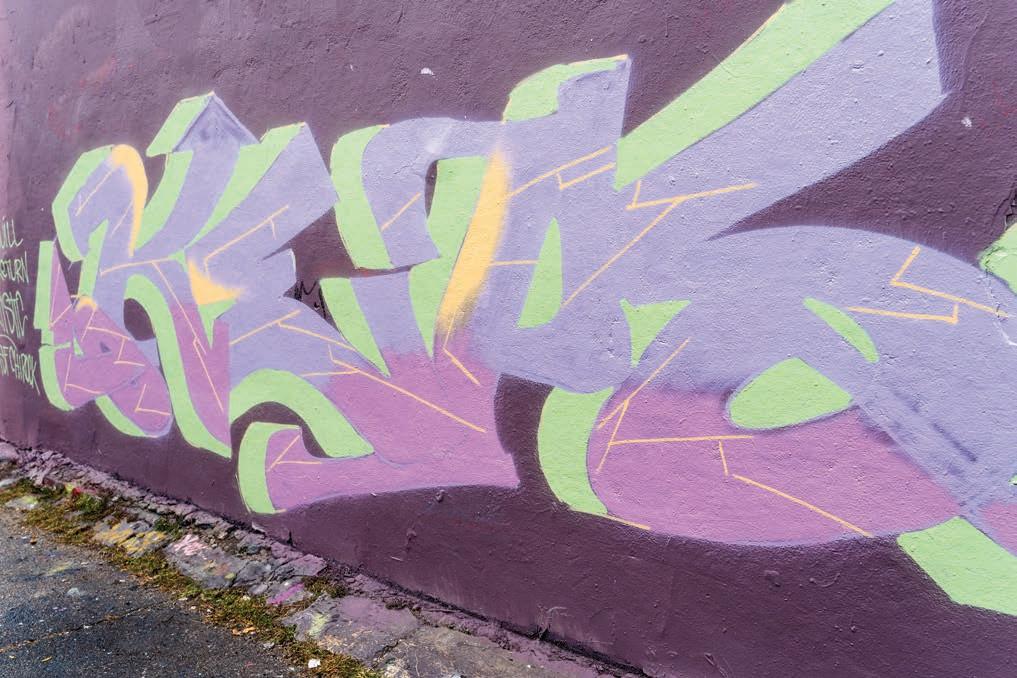
WHPK helped Roberts get a grip on what hip-hop culture meant. It played underground national artists as well as demos from unsigned locals, which meant that the Egyptian Breakers, who’d started to rap under the name Curfew Boys in 1985, could bring their cassettes to the station and try to get them played on the air. WHPK also aired bulletins about hip-hop events, such as writers’ meetings and
small shows at the nearby Blue Gargoyle.
In 1987, Roberts joined the Chi-ROCK collective, formed in ’85 by a handful of teens in Burnside to be a distinctively local hip-hop community organization. (“ROCK” originally stood for Respect Our Creative Kids, but the “K” now stands for “Kind” to reflect its multigenerational membership.) Chi-ROCK’s perspective was both an homage to and a reaction against Afrika Bambaataa’s Universal Zulu Nation, founded in 1973 and expanded into cities outside New York by the mid-80s. Bambaataa had a cousin in Chicago who rapped as Kool Rock Steady and represented Zulu, and Roberts says Chi-ROCK formed partly in response to his misguided recruitment strategy. Supposedly Kool Rock Steady had suggested that the only way to be a true hip-hop head would be to follow his lead—and Chicagoans didn’t take kindly to the idea of falling in line behind an emissary of New York.
Under the Chi-ROCK banner, Roberts helped lead a couple smaller crews focused on gra ti, including BASF, where Fere was involved too. By the late 80s, Roberts had become a force in the scene. “The community was pretty tightknit, and him and his partners were always trying to gather us and connect us all,” says veteran DJ Jesse de la Peña. De la Peña lived on the southwest side at the time, and he remem-
bers attending gra ti meetings that Roberts and his friends hosted outside the Museum of Science and Industry. “I met a lot of people at a lot of those meetings,” de la Peña says. “Finding hip-hop parties and finding people back then was a little harder—this was an opportunity to find people through gra ti.”
Even back then, Roberts showed a keen interest in documenting the scene. Rapper Deon “Mr. Club Banga” Coney, who used to record as JMD, remembers Roberts as constantly having a camera in hand. “He always felt it was important to cherish those things that involved the culture of hip-hop,” Coney says. “He would document, he would take pictures. He knew something that a lot of folks didn’t know—that eventually the day would come where we would have to have proof.”
Roberts understood that he had to share his work with other people if he wanted it to legitimize the overlooked Chicago scene in the eyes of the world. That’s why he and and Fere decided to launch Chicago Rocks in 1993. “We had no experience with publishing or anything like that,” Roberts says. “But we realized there was a need to put something out there to highlight what we was doing here in Chicago—that was enough inspiration for us to pick up a piece of paper and a pen and just get to work.”
Chicago Rocks didn’t enter a void. BboyB had cofounded FlyPaper a couple years earlier as The Rap Sheet. “We got a letter from the Rap Sheet out of LA saying, ‘You can’t use that name, we’re a hip-hop magazine,’” BboyB says. “We’re like, ‘Oh shit, this is a lawyer—we’ll leave that alone. Let’s come up with a new name.’ I think we came up with a better name.”
BboyB grew up in Logan Square. In the early 80s, he became one of the first people doing hip-hop gra ti in Chicago, and in 1983 he cofounded the Angel and Berto Crew (he’s Berto), one of the city’s longest-running gra ti squads (though “ABC” now stands for “Artistic Bombing Crew”). They hosted graffiti writers’ meetings at the benches by the Illinois Centennial Monument in Logan Square and went breaking at a nearby club called Jenals. As a student at Lane Tech in the late 80s, BboyB got exposed to more of the scene through his classmates, and he began to roam the city in search of hip-hop. He says he probably met Roberts at Steps, a far-north-side club run by hip-hop DJ and former New Yorker Parker Lee, aka P-Lee Fresh.
When he helped start The Rap Sheet in 1991, BboyB was studying at Columbia College, where he learned graphic design on the latest Mac computers. “Our saying was ‘ FlyPaper
publishes whenever the hell we feel like publishing,’” he says. “We didn’t have a set schedule. We didn’t have a budget. We didn’t have o ces.” BboyB had a friend who worked a night shift at Copy Max in Wicker Park, so he had free access to the shop’s computers. “I met a lot of punk-rock kids at two in the morning at Copy Max doing the same thing for their culture,” BboyB says. “This whole desktop publishing—making your own magazines and publishing your own stu —was just in the air. Everybody was doing it.”
FlyPaper started as a double-sided sheet and grew quickly before going on hiatus in 1995. (It had a second run in the 2000s.) The magazine printed work by William “Upski” Wimsatt before he founded Elevated and published his famous 1994 essay collection Bomb the Suburbs . It also gave Kevin Beacham his first byline, after he befriended the FlyPaper team through his Rage Promotions work—he’d give them promo copies of albums, and in ’93
they invited him to contribute. “They asked me to write one review, and I thought, ‘They’re gonna hate it,’ so I wrote three reviews, figuring that they’d feel guilty—like, ‘He wrote three, we gotta pick one,’” Beacham says.



“They loved them—they used all three. I was like, ‘There’s something to this.’” The following year, for the inaugural issue of Caught in the Middle, Beacham helped publish the first cover story on Common to appear anywhere.





“ Elevated , Chicago Rocks —which Artistic had for a while—they were all very similar and very cross-pollinated,” BboyB says. “But I like to say that the FlyPaper set the standard.”




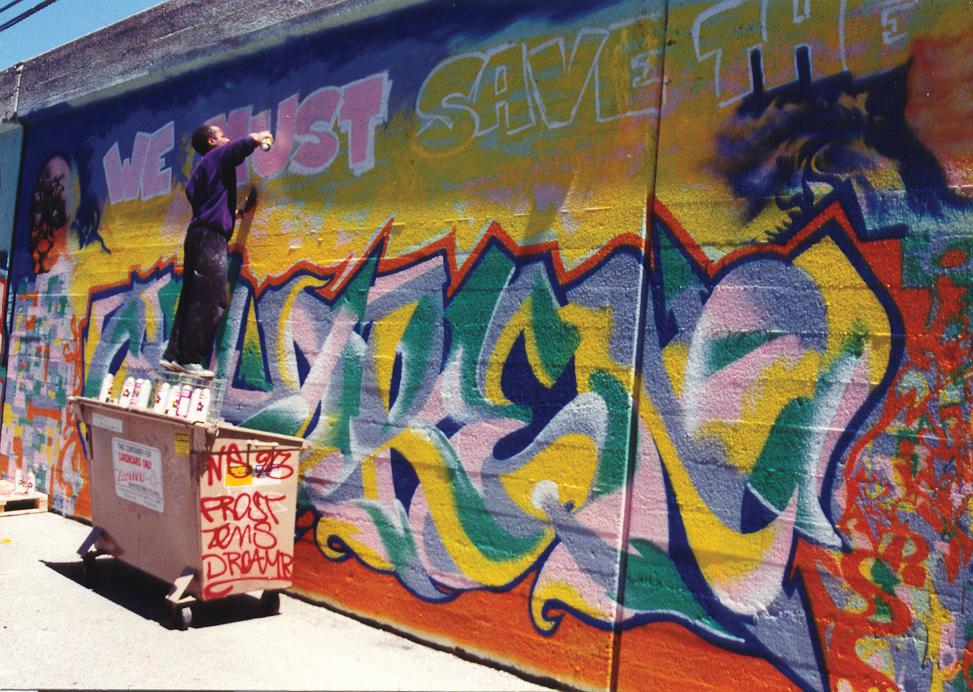
Chicago Rocks started as a bare-bones operation. After studying other magazines, Roberts and Fere laid out and assembled Chicago Rocks by hand—at first, they cut and pasted each page’s contents together. “We’re like, ‘OK, now how we gonna keep these things together?’” Roberts remembers. “We J

would look at magazines like, ‘Wait a minute, these got staples in them! How do you get them stapled?’ So we started taking staples and literally putting the staples in by hand— putting them through all the sheets of paper. After that we’d fold it, turn it over, and then fold the other side of the staple inward so it can contain all the pages. We were doing it all by hand until we actually got a stapler.”
Roberts and Fere took Chicago Rocks around to local shops to sell copies on consignment. Back then, Jesse de la Peña ran a hip-hop store in Brighton Park called the Yard, and he started selling Chicago Rocks alongside mainstream hip-hop magazines from the coasts. “It was great, because it felt like we had our own thing here in Chicago,” he says. “The store we had, we used to advertise in the magazine. It was just another way of connecting to other people.”
In the five years Roberts published Chicago Rocks , he says roughly 100 people pitched in—writing, taking photos, selling copies on the street. “We had a small team of sta people, but I was really the main engine behind making the magazine come out every month,” he says. Before he wound down the operation, Roberts managed to get copies into Tower Records, sending a few hundred to the chain’s Sacramento headquarters for distribution.
“We still really didn’t have a strong financial arm behind us, so I was making a lot of sacrifices,” Roberts says. “I was using my home as the office. We had an office from time to time, but nothing that was stable. The main place that we did most of the work, outside of utilizing other peoples’ homes and areas that we could get our hands on, was my home. Even my phone number became the o ce number for the magazine.” Roberts and his collaborators struggled to maintain a monthly publication schedule—only one issue of Chicago Rocks came out in 1996, and three the following year.
These days it’s hard to find copies of Chicago Rocks from its original five-year run (it rebooted in 2012 without Roberts, and last published in 2015). I recently spotted a couple copies on eBay—a 1998 issue with scene mover E.C. Illa on the cover was selling for $39.99, nearly 20 times the original price. Fortunately, Roberts plans to detail the magazine’s history in The Real Deal.
When BboyB looks at the wealth of hiphop history books that have come out in the past decade or so, he feels a little deja vu. “We started seeing these history books of hip-hop that didn’t include Chicago,”
he says. “It’s always like, ‘Hey, how come we’re not in this?’ We have a rich history here.”
When Roberts started reconnecting with old scene friends in 2015, he was also surfing the Web looking for books or documentaries on Chicago hip-hop’s history. “Nothing was coming up—or it would be fragments of stu , maybe an article here or an article there that was published in a newspaper,” he says. “In terms of books, nothing was coming up.” Among the top search results when you Google “Chicago hip-hop history” is a lengthy uncredited blog post from Giordano’s pizza—but to be fair, it’s pretty well done.
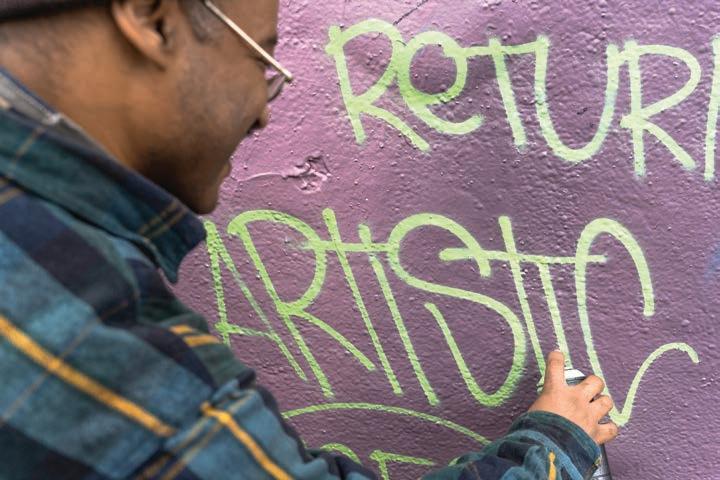
Roberts dug up the three-ring binder he’d used in the 90s to build the skeleton for his book, then set to work finishing The Real Deal He watched YouTube videos and combed the Web, sourced photos from Facebook, and reached out to friends and acquaintances for formal interviews. About a year ago, he called up Deon Coney.
“It was early one morning, and I was a little discombobulated,” Coney says. “But he documented it verbatim.” In the mid-80s, Coney helped put together a collective of rappers called Purple Mansion at Englewood High School. Through a friend, he met DJ Quickhands, who had a show at WHPK and would bring the crew into the studio to perform. Coney had his biggest success when Chicago producer Tyree Cooper tapped him to rap on “Move Your Body” in 1989. “I made a hiphouse record that did real well in the UK,” he says, “and I went on tour in the UK.”
The fourth episode of Netflix’s new rap competition show, Rhythm + Flow, opens with celebrity judge Chance the Rapper walking
through Chicago’s streets, accompanied by his own voice-over about the city’s hip-hop history—he names Twista, Lupe Fiasco, Kanye West, and Common. Before Chance and Chief Keef, those were the best-known artists to emerge from the city, and few mainstream books or articles have gone deeper. When Rolling Stone published a “Chicago hip-hop family tree” in 2017, scene veterans and fans alike were quick to point out its bizarre and conspicuous omissions. Legendary westsiders Crucial Conflict—whose breakout single, 1996’s “Hay,” was covered by the marching band backing Beyoncé at her 2018 Coachella set—didn’t make the cut, and group member Cold Hard posted a video complaining about it. If an artist of Crucial Conflict’s stature can get left out of a scene history by one of the biggest voices in music, then most of the rest of Chicago is definitely out of luck.
The Real Deal and Midway will expand this foreshortened narrative. Brockmeier and the Midway team have been building an expansive website for their documentary, since they can only fit so much into a feature-length film—they’re working on detailed biographies of scene players throughout the years, and Roberts is helping. Roberts also has those three other books in the pipeline, and plans to release one each November till 2022.
Whatever happens next, Roberts is likely to stay in the thick of it. “He’s one of those people that’s always been around, always been documenting,” Brockmeier says. “He’s a man of the hip-hop people.” No would-be historian could do right by Chicago hip-hop without him. v
 @imLeor
@imLeor






Sarah Vaughan singing “Once in a While” Some called her Sassy and some called her the Divine One. You can understand the dichotomy of Sarah Vaughan (1924-1990) by hearing her rendition of the 1937 Michael Edwards/Bud Green song “Once in a While.”
My favorite version comes from an appearance she made with her trio on The Dick Cavett Show, which I first saw in the 1991 documentary Sarah Vaughan: The Divine One , made for the Masters of American Music series on PBS (frequent collaborator Billy Eckstine praises her at the start of the clip).
The Voice Senior The American version of Dutch-created musical competition show The Voice sometimes fails to push its most unusual contestants to the finals, but other countries’ versions deliver on performers who would definitely get overlooked based on headshots. The Voice Senior (only open to those 60 and older) hasn’t happened here yet, but it’s produced in several other countries—the clips I’ve seen of contestants such as the Netherlands’ Noble and Germany’s Eduardo Villegas have convinced me to start a write-in campaign telling NBC to get on the Senior train.
The Big TEEN manifesto I discovered Chicago’s Big TEEN scene (o en styled “big TEEN”) through a press release on allegedly preeminent Big TEEN band Mega Laverne & Shirley (aka composer-performers Andrew Tham and Mabel Kwan). Big TEEN is an aesthetic movement, a way of life, and a cabal of bands, some real, some hyperreal. I don’t know what these people are selling, but I want it.

The Drifters Originally fronted by Clyde McPhatter, the Dri ers debuted in 1953 with “Money Honey.” They underwent many per-
sonnel changes, mostly due to conflicts with manager George Treadwell. He fired the first set of Drifters in 1958 and turned the Five Crowns (led by Ben E. King) into the “new” Dri ers. A er Ben’s tenure ended, Treadwell hired Rudy Lewis, who was gay, according to the notes in reissues of the box Rockin’ & Driftin’. Rudy is featured on such songs as “Up on the Roof” and “The Rat Race.” I wish I could see the TV appearances with him.
Curtis Mayfield and used in the 1988 movie Hairspray . She recorded other great songs in the 60s, including “I’m Over You” and “It’s Just Your Way.” She even wrote a great song for Billy Stewart, “I’m No Romeo,” for his 1965 album I Do Love You. I wish there were more available TV footage of Jan from the 60s.

Jay Mitta, Tatizo Pesa One of the best releases of 2019! An Afrofuturist gabber-grabbing, footwork-kicking, jungle-juggling adrenaline OD! The likes of Konono No. 1 and Crammed Discs’ Congotronics series fused Congolese tradition with ingenious DIY electronics to create the African equivalent of postpunk critique and edgy electronica, and Jay Mitta (and others on Ugandan label Nyege Nyege Tapes) do something similar with overt reference to 200-plus-BPM Western EDM. The speedy, jolly delivery of Tatizo Pesa is needed in these fascist-groove-thang times.
Kim Weston One of Motown’s most underrated artists of the 60s, Kim is best known for her 1967 duet with Marvin Gaye, “It Takes Two.”
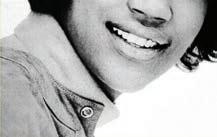
My favorite of hers is “Looking for the Right Guy” (1964), a bouncy, gritty tune by Smokey Robinson. It’s too bad she wasn’t on the April anniversary special Motown 60: A Grammy Celebration. Kim was mostly relegated to “C” status at Motown (the “chitlin’ circuit”) while Berry Gordy promoted the Supremes. I recommend her 1965 Hullabaloo appearance.

Jan Bradley Raised in south-suburban Robbins, Jan had a beautiful soprano, and recorded first for Formal, then for Chess. She’s best known for 1962’s “Mama Didn’t Lie,” written by
Various artists, Cosmic Collective: A Choir for the Dispossesed This flying international/interdimensional ice cream truck serves a blackened flavor rainbow of RABM (red and anarchist black metal). I recommend Antecantamentum’s “Tonantzin” (epic soundtrack intro to an imaginary movie), Vociferatus’s East Indian classical spice, Uthullun’s Killing Jokemeets-Voivod atmosphere, and Vulbo’s BM/ surf/mathcore/theremin gumbo. The compilation is seditious delicious!
YouTube effects-pedals demos I’ll help you move for a MASF Thornoscillator! A er a year or so of embracing current and older effects pedals (noise, glitch, modulation, etc) via YouTube demos, I feel extra inspired! Mutant pedals existentially threaten cultural immune systems maintained by blues lawyers/sheepish shredders/tone puritans. Resistance to rejuvenated global reactionaries arrives in the rush of confrontational utopian soundscapes— pedals as weapons of mass seduction! v
SEPTEMBER20..... DAVIDQUINN
SEPTEMBER21.....WAGNER&MORSE
SEPTEMBER22.....THE DYNAMOS

NOVEMBER
SEPTEMBER23....WHOLESOMERADIODJNIGHT
NOVEMBER
FEBRUARY24..... DARK ROOMMEN WHITEWOLFSONICPRINCESS MOJO49
NOVEMBER
NOVEMBER
NOVEMBER
MURPHYTHOMPSON9:30PM
MIKEFELTEN
THERONANDRACHELSHOW
FEBRUARY25.....WHOLESOMERADIODJNIGHT
NOVEMBER
FEBRUARY26.....RCBIG BAND7PM
SEPTEMBER24.....RCBIGBAND7PM BIRDGANGS9:30PM
NOVEMBER 9RONNIE
NOVEMBER 10HEISENBERG
DUDESAME
FEBRUARY28.....PETERCASANOVA QUARTET8PM
11RC BIG BAND
SEPTEMBER26.....PETERCASANOVAQUARTET
PROSPECT FOUR 9:30PM
MARCH1............SMILIN’ BOBBYANDTHECLEMTONES

SEPTEMBER27.....DORIAN TAJ
NOVEMBER 12FLABBY
NOVEMBER 13ELIZABETH’S
MARCH2............ICE BOXANDBIGHOUSE
SEPTEMBER28..... TOURS BULLYPULPIT
NOVEMBER
SEPTEMBER29.....SOMEBODY’SSINS
MARCH3............CHIDITARODAND TARRINGTON10PM

FEATURINGJOELANASA

SEPTEMBER30.....OFFTHEVINE4:30PM
NOVEMBER
MARCH7............ JAMIE WAGNER&FRIENDS
NUCLEARJAZZQUARKTET7:30PM
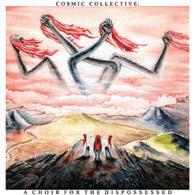




Traditional Mongolian and Tuvan music make natural raw materials for folk-metal fusion, with their regal, windswept tonal palette, their challenging, eerie-sounding vocal styles, and their epic, equestrian-warrior-themed lyrics. So while I’m not the least bit shocked that the Hu (“hu” is a Mongolian root word for a human) sound as good as they do, I am pleasantly surprised by how fast the band have taken off among mainstream metal and hard-rock fans. Since the Hu formed in Ulaanbaatar in 2016, their cinematic, rousing, and witty music videos have been watched by
Junkyard Samurai Tiny Chain Gang and Thewhoevers open. 9 PM, Beat Kitchen, 2100 W. Belmont, $12. 17+
When Chicago MC Probcause teamed up with local hip-hop duo the Palmer Squares to release an EP as Junkyard Samurai last year, it seemed like a perfect fit. As the Palmer Squares, rappers Acumental and Terminal Knowledge have dropped track a er track stuffed with voluble, flamboyant lines delivered with a playful bounce. Probcause can also make his words ricochet like rubber, and his whimsical sensibilities, combined with hard-as-nails rapping, have helped him cross over into EDM—he’s delivered steely performances on overdriven productions by
millions, and their songs “Wolf Totem” and “Yuve Yuve Yu” have cracked the top ten on the Billboard digital hard-rock chart—not too shabby for a group who use traditional Mongolian instrumentation and throat singing (and don’t write lyrics in English). Last month, these modern traditionalists released their full-length debut, The Gereg (Eleven Seven), and it does not disappoint. Its songs have a potent sense of atmosphere and momentum, and the pining, reedy sound of the morin khuur (horsehead fiddle) adds a soulful drone that’s strong enough to lift even the thinner tunes high. —MONICA KENDRICK
in 2009, Blackshaw retired from the biz, and Barker went off the radar to raise a family. But in 2008, the Numero Group released the excellent compilation album Wayfaring Strangers: Guitar Soli , which features meditative recordings by obscure guitarists, including Ted Lucas and George Cromarty, and since launching in 2005 the Tompkins Square label has been serving up archival rarities by Max Ochs and Harry Tausig as well as releases from emerging artists Ryley Walker and William Tyler. It’s clearly too early to declare the fingerstyle scene moribund, with troubadours such as Steve Gunn, Daniel Bachman, Cian Nugent, and Matthew J. Rolin actively touring and putting out new music. Rolin brought his adept playing and laidback demeanor to Chicago from Cleveland in 2017, and after he lit up the DIY landscape here, he toured with earthy local avant-rockers Health & Beauty. In January, Rolin dropped the cassette Moment (Blue Hole), which is full of sublime, ruminative solo guitar. Rolin seems to be building momentum: a composition of his just appeared on the ninth volume of Tompkins Square’s Imaginational Anthem anthology series (this one curated by Ryley Walker), and his self-titled debut LP is due on the prolific Feeding Tube label in November. The album shows Rolin’s growing maturity, augmenting its warm acoustic guitar with delicate layers of violin, chimes, tambourines, and other heavy vibe setters. In early 2018 Rolin moved back to Ohio, where he’s launched the Powers/Rolin Duo with his partner, dulcimer player Jen Powers, and this is his first solo appearance in Chicago since then—so it’s time to soak up his heady sound tapestries, which will surely sound divine in the autumnal air. —STEVE KRAKOW
the likes of Griz and Gramatik. On Junkyard Samurai’s self-titled 2018 EP, their voices zoom around one another so cleanly that you could be forgiven for thinking these three kindred spirits have been working together their entire careers. In fact they’ve only recently started collaborating like this, but given how much fun they seem to be having on the recent EP Remask (Spooky Language/Feel Good Music), something tells me they’ll spend the rest of their lives making up for lost time. —LEOR GALIL
The hu See Pick of the Week above. Doomriders and Lightning Born open. 7:30 PM, House of Vans, 113 N. Elizabeth, free with RSVP to eventbrite. com/e/hallowol at-tickets-62597141736. 18+
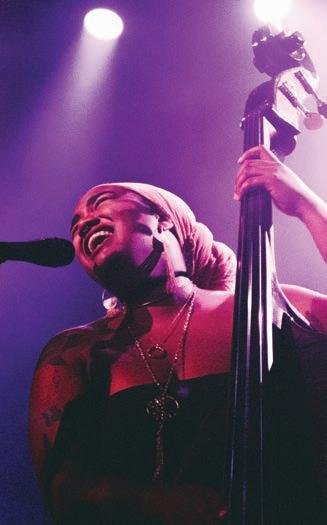
Matthew J. Rolin Mute Duo and Phish DJ Set open. 8 PM, Outer Sound, 3323 W. Armitage, $5-$10 donation requested, b
In ye olde late 90s, American Primitive fingerstyle guitar by the likes of Robbie Basho, Sandy Bull, and Peter Walker seemed to come back into fashion, possibly because the founder and overlord of the genre, John Fahey, was making some very cool new experimental records. A er Fahey died in 2001, adept pickers such as Jack Rose, Kevin Barker (of Currituck Co.), and James Blackshaw appeared to pick up the torch and run with it. Sadly, by the end of the decade, the well of solo underground acoustic guitarists seemed to dry up: Rose passed away
Tonina Loona Dae opens. 9 PM, Hungry Brain, 2319 W. Belmont, $10. 21+



The first time I heard bassist, guitarist, and singer Tonina Saputo, her voice stopped me in my tracks—her delicate phrasing and heart-wrenching poignancy brought Billie Holiday to mind, except that she was singing in Spanish as well as English. The song was a cover of “Historia de un Amor,” a torchy Panamanian bolero written in the 1950s by Carlos Almarán that’s beloved throughout Latin America, and I wasn’t the only one impressed by her version—Barack Obama listed it among his top songs of 2018. Tonina’s songs have lots of soul and the occasional rap, and their textures recall her musical idols, among them Selena and Lauryn Hill. Her debut album, 2018’s Black Angels , also features an abundance of flamenco rhythmic flourishes—a by-product of her studies in Spain. Produced by Madrid singer-songwriter Javier Limón and released on his Casa Limón Label, the record contains Tonina’s interpretations of Spanish-language standards. At this show she’ll likely perform pieces from Black Angels as well as tunes from her recent second album, St. Lost, recorded at Native Sounds studio in her hometown of Saint Louis. The new record comes from a more focused personal perspective, and Tonina seems to have found her true groove in its R&B-infused and lightly jazzy folk-soul, which she propels with the power of her velvety voice.
—CATALINA MARIA JOHNSON

Young Guv See also Saturday. Vivian Girls headline; Young Guv and Reckless DJs open. 9 PM, Empty Bottle, 1035 N. Western, $20. 21+


Toronto’s Ben Cook is well-known as the front man for early aughts tough-guy hardcore outfit No Warning and as the third guitarist in posteverything punk collective Fucked Up, but the bulk of his discography consists of a seemingly unending stream of multifaceted solo releases under the alias




Young Governor, which he o en shortens to Young Guv. Starting in 2008 with the seven-inch “Virginia Creeper” and the EP Hidden Love , Young Guv at first tilted toward frenetic, Jay Reatard-flavored one-man garage punk with a heavy dose of melody. But Cook has been expanding on this formula ever since, delving into Cure-style goth pop on the 2009 single “Bedtime Stories,” Mats worship on 2011’s Where It’s Quiet, dance-pop on his singles as Yacht Club, and lo-fi electro funk on last year’s 2 Sad 2 Funk. This summer’s Guv I (Run for Cover) features Cook’s best work yet. With a running time of only 22 minutes, the album is an all-too-quick glammy power- pop trip whose songs lurch like T. Rex and glimmer like Big Star, with the sharpest hooks and melodies on a rock record this year. Last week, Cook released a companion to Guv I called J


continued from 31
Guv II, which skews a bit more calm and introspective than the stomp and swagger of its predecessor. Instead it suggests a modern-day R.E.M. or the Byrds, and its twinkling songs feel warm and lived-in. All the sides of Young Guv are excellent— even as Cook strays further from his punk roots, he’s still the best at whatever the hell he’s doing.
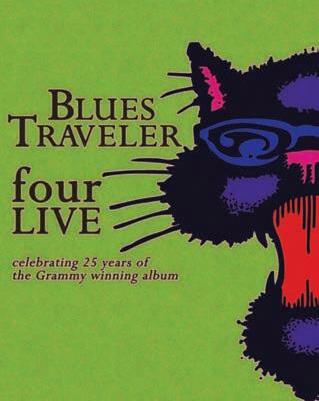
 —LUCA CIMARUSTI
—LUCA CIMARUSTI

Maxo Kream Q Da Fool and Slayter open. 8 PM, Bottom Lounge, 1375 W. Lake, $22-$52. b



Few rappers sound as comfortable with introspection as Houston’s Emekwanem Ogugua Biosah Jr., aka Maxo Kream. Even the title of his recent second album, Brandon Banks (RCA/Big Persona/88 Classic), references his troubled past: his father, Emekwanem Ogugua Biosah Sr., ran scams under that name and spent much of Maxo’s childhood serving time on fraud charges. On “Bissonnet,” the 29-year-old rapper focuses on the effects this had on his adolescence, squeezing enough emotions to fill several chapters of a memoir into a couple of lucid, unflinching lines: “Police kickin’ in my door, threw my momma on the floor / HPD took my pops, I bought a heat, hit the block.” Throughout Brandon Banks, Maxo’s rapping combines youthful vigor with the clarity of someone wise beyond his years— he unloads dense blocks of insightful autobiography with the adrenalized flair of a skateboarder pulling off every conceivable flip in an abandoned pool. Even when he raps about feeling adri in the streets as a kid, Maxo sounds like he’s got a better grip on his future than most of his peers have on theirs. —LEOR GALIL
Ten years ago, “Gee!” by Girls’ Generation became one of the first K-pop singles to break out of South Korea. The success of that track made the group stars in Japan and the U.S. years before Psy went viral with “Gangnam Style”—and even longer before the arrival of the omnipresent BTS. Thanks in part to Girls’ Generation’s efforts, K-pop is now a global phenomenon, but the group itself has been on hiatus since 2017 while several of its eight members, including California native Tiffany Young, pursue solo careers. The lead single and title track of Young’s debut solo EP, 2016’s I Just Wanna Dance, pulls more from Carly Rae Jepsen-style Western retro-pop than from any of her K-pop contempo-

raries. This year, she’s flirted with trop-pop on “Born Again” and artfully incorporated Eurodance-style piano stabs on “Magnetic Moon.” Her most recent single, “Run for Your Life,” is the kind of dramatic synth-pop that Lady Gaga defined at the turn of the decade (the song’s producer, Fernando Garibay, has worked extensively with Gaga). Young isn’t merely a pop-star myna bird, flitting from sound to sound and repeating the bits she likes, but it does seem that she’s still settling on a niche as a solo artist. That said, she sounds more self-assured than ever on “Run for Your Life,” cackling rhythmically over its massively ominous synths. That confidence will only help her on this tour, as she’s playing much larger venues than she did this spring on her first North American solo trip, an eight-city jaunt called Lips on Lips. Her Chicago stop in March at Lincoln Hall featured snippets of Girls’ Generation songs sprinkled into a mix of originals and covers, plus a postconcert Q&A. Hearing bits of Girls’ Generation hits such as “Talk Talk” and “Into the New World” clearly excited Young’s longtime fans, but as she establishes herself, even those brief nostalgia trips may soon be a thing of the past.
—ED BLAIRYoung Guv See Friday. Vivian Girls headline; Young Guv and Bric-a-Brac DJs open. 9 PM, Empty Bottle, 1035 N. Western, $20. 21+

Magic Sword Droid Bishop opens. 9 PM, Beat Kitchen, 2100 W. Belmont, $20. 17+
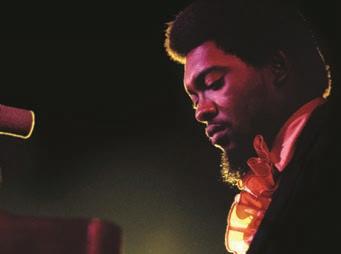

For more than a decade, pop culture has witnessed an explosion of 1980s sci-fi and horror revivalism in both music and film with dark electro-pop acts such as Kavinsky and creepy period dramas such as Stranger Things garnering cult followings. Amid



the nostalgia, an anonymous, instrumental, Boisebased synth-rock trio named Magic Sword has carved its own stylistic niche. Its members—credited as the Keeper of the Magic Sword, the Seer of All Truths, and the Weaver of All Hearts and Souls— take as much inspiration from John Carpenter as from Da Punk to create a funky, metallic, ominous soundtrack to their own comics-inspired canon. Onstage, the trio adorn themselves in cloaks and colorful LED masks (which remind me of Squarepusher’s Shobaleader One project), with flickering strobes, vibrant stage lights, and light-up novelty swords setting the mood around them. A week before Halloween, Magic Sword released a new LP called Awakening, whose triumphant title track segues from a squealing, saxlike synth lead into epic, distorted melodies, a moody downtempo section, and a clean guitar groove that recalls Nile Rodgers on Da Punk’s “Get Lucky.” This is going to be a fun one. —SCOTT MORROW
Djunah The Cell Phones and Imelda Marcos open. 8:30 PM, Empty Bottle, 1035 N. Western. 21+ F
If you’re fond of the loud, outre rock bands that have emerged in Chicago over the past decade or
so, Djunah have your number. Front woman Donna Diane (aka Donna Polydoros) and drummer Nick Smalkowski previously played in two of the mightier groups on the scene: Beat Drun Juel and Fake Limbs, respectively. As Beat Drun Juel petered out toward the end of 2017, Diane tinkered with solo sets under the name “Naked, Riding a Lion Made of Fire,” playing guitar and adding bass notes with a foot-operated Moog Taurus pedal synthesizer. She’s told the Tribune that after she performed at Ian’s Party in January 2018, she realized she needed a drummer. She reached out to Smalkowski, who’s proved to be a great collaborator, and this headlining show at the Empty Bottle doubles as a celebration of Djunah’s new debut album, Ex Voto (Triple Eye Industries). Diane recently explained to music blog Destroy Exist that progressive politics influenced much of the record: on “Bless Your Money,” for instance, she sings about how the amorality of capitalism renders people soulless. It can be hard to tell exactly what Diane is condemning, especially when her voice climbs into its harshest screams, but Djunah always communicate their emotions loud and clear. They play their aggressive, furious songs like they’re taking their frustrations out on their instruments, though the sharpness of their performances speaks to an impulse more constructive than pure anger. If the rest of us can pull through this hellish state and emerge with something as clear-eyed and focused as Ex Voto, then the future might not be as hopeless as it looks.


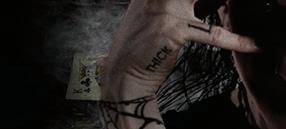





Preservation Hall Jazz Band With special guests including Cuban singer-songwriter Yusa. 8 PM, Thalia Hall, 1807 S. Allport, $30$45. 17+


The word “preservation” implies something kept under glass, unable to breathe if not simply dead— but the members of the Preservation Hall Jazz Band swing so hard that “rejuvenation” would be a better way to describe their sound. Named for the Preservation Hall in the French Quarter of New Orleans, the PHJB assembled its original lineup in the early 1960s from older jazz musicians such as Sweet Emma Barrett (for whom Cannonball Adderley named his song “Sweet Emma”), George Lewis, De De and Billie Pierce, and Willie and Percy Humphrey. Except for a brief stretch after Hurricane Katrina in 2005, the band has been a constant presence for nearly six decades, with new generations of members keeping the groove of their predecessors going strong. Currently led by bassist Ben Jaffe, the PHJB has developed a remarkably subtle take on traditional New Orleans jazz. You can feel the bayou sound, but it’s not exaggerated or cliched like a backing track in a Popeye’s Chicken commercial—and when trombonist Ronnell Johnson puts a plunger up to his bell, his tone gets nasty in the best of ways. The PHJB isn’t simply replicating the music of times gone by, but neither does it use modern effects that will sound dated a week from now. Its most recent album, So It Is (Legacy), coproduced by Dave Sitek from TV on the Radio, incorporates Afro-Cuban influences and emphasizes the roots those sounds share with New Orleans jazz. So it is; so it was; so it ever will be.
—JAMES PORTER

Tomeka Reid 8:30 PM, Constellation, 3111 N. Western, $17. 18+






Next time you think you’re busy, look at Tomeka Reid’s schedule. Even though the cellist was already committed to touring Europe with Rob Mazurek’s Exploding Star Orchestra and the Art Ensemble of Chicago, she just assumed the position of Darius Milhaud Distinguished Visiting Professor at Mills College in Oakland, California (even though she’s based in Queens, New York). And when she’s not racking up the miles to meet playing and teaching engagements, she’s squeezing in a tour to support the release of Old New (Cuneiform), the recent second album by the Tomeka Reid Quartet. When the group’s self-titled debut album was released in 2015, they were a band of rising stars. Chicago-based bassist Jason Roebke was already a bandleader as well as a first-call accompanist for local ensembles led by Mike Reed, Josh Berman, and Jason Stein. New York-based guitarist Mary Halvorson and drummer Tomas Fujiwara were already leading their own ensembles, playing in each other’s bands, collaborating with bassist Michael Formanek in the collective trio Thumbscrew, and working separately or together with Taylor Ho Bynum, Tom Rainey, and Ingrid Laubrock. But now, between Reid’s prestigious new gigs, Fujiwara’s superb and highly acclaimed Triple Double project, and Halvorson’s recent MacArthur Foundation grant, it’s fair to say that the stars have ascended into the firmament. Reid’s compositions on Old New exploit the skills and versatility of each musician: Fujiwara’s ability to shi from skipping brushwork to full-on barrage; Halvorson’s capacity to shi between blunt, distorted blasts and a delay-multiplied drizzle of squelchy tones; Roebke’s easy flips between party-time pulses and gravely dignified solos; and her own unerringly intricate pizzicato playing and singing bowed leads. But what makes this record sound like the work of a real band and not just a bunch of hotshots is the way each musician works behind the others, adding accents and leaving spaces that make their mates sound even better. —BILL MEYER
IT WAS PLENTY warm out when Chicago postpunks Ganser played their noontime set at this year’s Riot Fest, but their dark, thrilling jams still gave Gossip Wolf chills. Maybe it was heat stroke from wearing all black? Anyway, Ganser have long been masters of atmospheric, swirling riffs, and their new EP, You Must Be New Here , is the work of a veteran band at the peak of their powers. Opening cut “Buio” channels the catchy melancholy of Echo & the Bunnymen and Psychedelic Furs, and seems destined for lots of lovelorn mixtapes. At 6:30 PM on Saturday, November 2, Ganser celebrate with a free in-store show at Record Breakers; the EP doesn’t officially drop till Friday, November 8, but the band plan to have copies on hand. (Ganser also open for Sports Team at Cobra Lounge on Thursday, October 31.)
Experimental guitar-and-drums duo Sun Speak blend jazz, chamber music, and postrock into something enchanting and hypnotizing. Last week, Flood Music released the local instrumental group’s fourth album, Moon Preach , and autumnal-sounding cuts such as the unhurried, minimal “Quilt” provide a good excuse to make a seasonal fall playlist. On Sunday, November 3, Sun Speak welcome their new full-length to the world with a headlining set at the Hideout. Katie Ernst opens, and tickets are $10.
For the past few years, Chicago indierock band Joey Nebulous have been cooking up lighthearted, stripped-down tunes they describe as “queer twee pop.”
Front man Joseph Farago sings romantic lyrics in a delicate falsetto well suited to intimate venues—and on Sunday, November 3, Joey Nebulous headline the Empty Bottle to support their latest album, Give Yourself a Kiss for Me, which came out on Philadelphia’s Sleeper Records in September. Twisted Flower, Julia Steiner, and Henry Hank open. Tickets are $8 ($5 in advance), and the show starts at 8:30 PM.
—J.R. NELSON AND LEOR GALIL
Got a tip? Tweet @Gossip_Wolf or e-mail gossipwolf@chicagoreader.com.

R.lum.r 3/19/20, 7:30 PM, Schubas, on sale Fri 11/1, 10 AM, 18+
Andy Shauf, Molly Sarle 3/7/20, 8:30 PM, Thalia Hall, 17+
She Wants Revenge, Guidance 12/19, 8 PM, Lincoln Hall, 18+
Slow Hollows 2/21/20, 9 PM, Schubas, 18+
Sons of the Silent Age, Ready Freddies 1/11/20, 7 PM, Metro, 18+
Spaga 1/4/20, 2 PM, City Winery b
Squirrel Flower, Why Bonnie 4/7/20, 7:30 PM, Schubas b
Wesley Stace, Robert Lloyd 1/31/20, 8 PM, SPACE, Evanston b
Marty Stuart & His Fabulous Superlatives 3/20/20, 8 PM, Maurer Hall, Old Town School of Folk Music, on sale Fri 11/1, 9 AM b
Algiers 4/3/20, 9 PM, Empty Bottle, on sale Fri 11/1, 10 AM
Anna of the North 2/25/20, 7:30 PM, Lincoln Hall, on sale Fri 11/1, 10 AM b Anniversary 1/30/20, 8:30 PM, Lincoln Hall, 18+ Peter Asher 1/3/20, 8 PM, City Winery b
William Basinski performs On Time Out of Time 1/3/20, 9 PM, Empty Bottle, on sale Fri 11/1, 10 AM
Bloodiest, Tombstone Eyes, Sweet Cobra, Tight Phantomz 12/7, 8:30 PM, Empty Bottle, on sale Fri 11/1, 10 AM The Bridge #2.02 with Mai Sugimoto/Raymond Boni/ Anton Hatwich/Paul Rogers 11/8, 9 PM, Doug Fogelson Studio, donations accepted F b
Ronnie Baker Brooks 12/27, 9 PM, FitzGerald’s, Berwyn, on sale Fri 11/1, 11 AM
Sam Bush 2/7/20, 8 PM, Maurer Hall, Old Town School of Folk Music, on sale Fri 11/1, 9 AM b
Chicago 4/7/20, 7:30 PM, Rialto Square Theatre, Joliet b Claudettes, Nora O’Connor 1/4/20, 8 PM, City Winery b Cloakroom, Pinebender, Sorespot 12/22, 8:30 PM, Empty Bottle
Albert Cummings 3/15/20, 8 PM, SPACE, Evanston b Dan Deacon 4/2/20, 9 PM, Metro, on sale Fri 11/1, 10 AM, 18+
Destroyer, Eleanor Friedberger 3/1/20, 8 PM, Thalia Hall, 17+
Driver Era 4/25/20, 7:30 PM, the Vic b Dustbowl Revival 3/20/20, 8 PM, SPACE, Evanston b
Easy Life 3/6/20, 9 PM, Schubas, 18+ Emo Night Brooklyn 12/13, 10 PM, Metro, 18+ Evan Giia 3/27/20, 9 PM, Schubas, 18+ Hammerfall, Beast in Black, Edge of Paradise 10/7/20, 7 PM, Concord Music Hall, 17+ Juliana Hatfield 1/16/20, 8 PM, SPACE, Evanston b Dave Hause & the Mermaid 3/6/20, 8 PM, Sleeping Village Headache, Hedra Rowan, Daniel Wyche 11/13, 9:30 PM, Hideout Hemhora & the Glass Band, Mint Mile, Jake McKelvie 11/10, 8 PM, GMan Tavern Hot Water Music 3/21/20, 8 PM, Cobra Lounge, 17+ David Keenan 11/17, 3:30 PM, Top Note Theatre at Metro, 18+ F
Tori Kelly, Audrey Mika 2/16/20, 8 PM, Riviera Theatre, 18+
Kindred the Family Soul 2/7/20, 7 PM; 2/8/20, 7 and 10 PM, City Winery b Kitchen Dwellers, Old No. 8 12/7, 9 PM, Martyrs’

Sammi Lanzetta, Leopard Print Taser 12/5, 8 PM, GMan Tavern Lawrence 4/11/20, 8 PM, Bottom Lounge, on sale Fri 11/1 b Levin Brothers 1/16/20, 7:30 PM, Reggies’ Music Joint second floor Howard Levy 4 2/23/20, 7 PM, SPACE, Evanston, on sale Fri 11/1, 10 AM b
Lil Tecca 11/15, 6 PM, Patio Theater b Lloyd 11/13, 7 PM, Chop Shop, 18+
Lone Bellow, Early James 4/4/20, 8 PM, Thalia Hall, 17+
Lucky Boys Confusion, Cold Mourning 12/21, 1 PM, Bottom Lounge, 17+
Lucky Boys Confusion, Plain White T’s, AM Taxi 12/21, 7 PM, Bottom Lounge, 17+ Magic City Hippies 1/31/20, 9 PM, Metro, 18+ Maverick Sabre 1/20/20, 7:30 PM, Schubas b Tate McRae 1/23/20, 7 PM, Schubas b Melkbelly, Hecks 12/28, 9:30 PM, Hideout, on sale Fri 11/1, 10 AM
Mipso, Bridget Kearney, Benjamin Lazar Davis 1/25/20, 8 PM, Maurer Hall, Old Town School of Folk Music b Mock Nine, Friko, Monarchy Over Monday, Neptune’s Core 11/30, 6 PM, Martyrs’ b Molice 11/19, 8:30 PM, Empty Bottle
John Moreland 4/3/20, 8:30 PM, Thalia Hall, 17+ Ron Morelli, Justin Aulis Long, Traxx 12/27, 10 PM, Smart Bar Mura Masa 4/29/20, 8 PM, Riviera Theatre, on sale Fri 11/1, 10 AM b
My Life With the Thrill Kill Kult, I:Scintilla, Conformco, DJ Greg Corner 11/7, 7 PM, Chop Shop, 18+ Brett Naucke, Civic Center 12/4, 8:30 PM, Empty Bottle Necks 4/10-4/11/20, 8:30 PM, Constellation, 18+
DJ Nobu, Jeff Derringer, Sevron 11/16, 10 PM, Smart Bar NRBQ 11/27, 8 PM, Chop Shop Papooz 2/24/20, 8 PM, Schubas, on sale Fri 11/1, 10 AM, 18+ Gregory Porter, Ledisi 3/27/20, 7 PM, Chicago Theatre b Post Child, Secret Colours, Faint Life, DJ Jen Dot 12/2, 8:30 PM, Empty Bottle F Railroad Earth 3/7/20, 8 PM, the Vic, on sale Fri 11/1, 10 AM, 18+ Revivalists 3/14/20, 8 PM, Aragon Ballroom, 17+
Tallest Man on Earth, Courtney Marie Andrews 3/12-3/14/20, 8 PM, Maurer Hall, Old Town School of Folk Music, 3/13 & 3/14 sold out b Louis Tomlinson 6/10/20, 8 PM, Chicago Theatre, on sale Fri 11/1, 10 AM b
Tops 4/24/20, 9 PM, Empty Bottle
Walter Trout 3/28/20, 7 and 10 PM, SPACE, Evanston, on sale Fri 11/1, 10 AM b
Veldt, Fuj, Peace Treaty, JS Alvarez 11/14, 10 PM, Smart Bar F
Verluna, North by North, Jessica Mindrum 12/11, 8:30 PM, Empty Bottle
Young Dolph, Key Glock 3/15/20, 8 PM, the Vic, 18+ Your Smith 1/22/20, 8 PM, Schubas, 18+
Batushka, Hate 12/10, 8 PM, Metro, canceled; contact point of purchase for refund information, 18+ Irish Christmas in America with Niamh Farrell, Séamus Begley 11/30, 5 and 8 PM, Maurer Hall, Old Town School of Folk Music, 5 PM show added b
Loud Luxury, Justin Caruso 11/7-11/8, 6 PM, Concord Music Hall, 11/7 added; 11/8 sold out b
Allah-Las 11/27, 10 PM, Thalia Hall, 17+
Anamanaguchi, Terror Jr, Hana, James Ivy, Meishi Smile 11/10, 8 PM, Bottom Lounge, 17+ Antenes & Erika, BMG, Bill Spencer 11/15, 10 PM, Smart Bar
Aqueous 11/16, 9 PM, Lincoln Hall, 18+
Audien 11/15, 8 PM, Concord
Music Hall, 18+ Automatic 11/26, 9:30 PM, Hideout
Aweful, Blood People, Dorian Taj 11/30, 9:30 PM, Hideout Blood Cultures 11/27, 9 PM, Schubas, 18+ Blossoms, Inhaler 11/10, 8:30 PM, Subterranean, 17+ Kinky Friedman 11/16, 10 PM, SPACE, Evanston b Anthony Hamilton 11/23, 8 PM, the Venue at Horseshoe Casino, Hammond Harley Poe, Homeless Gospel Choir 11/9, 9 PM, Beat Kitchen, 17+
Icon for Hire, Veridia 11/7, 7:30 PM, Subterranean b Chris Ligon CD Release and Variety Show with Flat Five, Sharon Rutledge, and more 11/8, 8 PM, FitzGerald’s, Berwyn
Del McCoury Band 11/16, 8 PM, Maurer Hall, Old Town School of Folk Music b
PJ Morton 11/16, 8 PM, Concord Music Hall, 18+ Charlie Parr, Al Scorch 11/8, 8:30 PM, Schubas
Pigface 11/30, 8:30 PM, Thalia Hall, 18+
Plaid, Steve Hauschildt, Abstract Science DJs 12/14, 9 PM, Sleeping Village
This Will Destroy You, Christopher Tignor 11/19, 9 PM, Sleeping Village Tierra Whack 11/26, 8 PM, Concord Music Hall, part of Red Bull Music Festival Chicago, 18+ Trigger Hippy 11/15, 8 PM, Beat Kitchen
Ultramagnetic MC’s, Samiam the MC 11/9, 10:30 PM, Reggies’ Rock Club, 18+ Windy City Crash Popfest
2019 with Bloody Knives, Panda Riot, Emmaline Twist, Lightfoils, Citrus Clouds, Cathedral Bells, Fauvely 11/16, 5 PM, Co-Prosperity Sphere, 17+
Wingtips, Pixel Grip, Star Tropics, Feeltrip DJs 11/22, 9 PM, Empty Bottle
Jamila Woods 11/27, 8 PM, the Geraghty, part of Red Bull Music Festival Chicago, 18+ Wume, Bitchin Bajas, Watery Follies 11/25, 8:30 PM, Empty Bottle F
Pete Yorn with Day Wave, Michigander 11/19, 7:30 PM, Metro, 18+ Zeta, Crowning, Porcupine 11/24, 8 PM, Subterranean, 17+ v
Q : My little dick has always held me back. I didn’t date in high school because I couldn’t stand the thought of girls discussing my tiny manhood. That said, I’ve adapted fairly well and become skilled with my tongue and hands. The biggest problem is that my dick is just small enough that the head pokes straight forward and can be seen through my pants. I never tuck in a shirt because of it. Because I am always in oversize shirts that hang past my waist, I never look professional. I’ve tried stuffing with socks and it didn’t work. Do you know of anything that can mask a pathetic johnson? I’d love to move up in the world.
A : Have you considered packing? Trans men, drag kings, butch dykes, and even straight cis women experimenting with gender expression will sometimes pack—that is, wear “packing dildos” that create the appearance of a masculine bulge. Packers are modeled on so cocks, not hard cocks, and they come in a range of sizes and colors. And so long as you don’t engage in false advertising, PENIS—so long as you make it clear to new partners that the bulge in your pants is not a prologue— there’s no reason why you couldn’t pack, just as there’s no reason why you and other guys with small dicks can’t strap on a regular dildo when your partner wants a deep dicking.
Q : I’m a mid-20s straight woman, and there’s a pattern in my life that I’m trying to break. Since high school, I’ve repeatedly ended up being friends with wonderful men who I shared an obvious sexual tension with at the start of our “friendships.” (Our mutual friends o en noted the sexual tension.) Not a single one has ever turned into more than a one-off drunken kiss. Maybe it’s who I’m picking, but I’m starting to think that I’m the problem. An ex of mine (who I met on Bumble) told me that I give off “don’t touch me” vibes. Looking back, I can see that all my relationships started in settings where romantic interest was implied—apps, blind dates, etc. I’ve been spending a lot of time with a classmate of mine. We get along well, and he’s hot and single. How do I (for lack of a better term) seduce him?
A : Don’t seduce, ask. Don’t put the moves on someone, use your words—or think of your words as your move, DTFZ. Since you give off “don’t touch me” vibes (that’s some valuable feedback from an ex!), and since we’ve asked men to do a better job of perceiving and respecting a woman’s “don’t touch me” vibes, you will have to make your interest clear and unambiguous:
“Hey, classmate, we’ve been spending a lot of time together, and I was wondering if you might be interested in going on a date sometime.”
Q : I have had a very hot, sexy bodybuilder friend with benefits for many, many years. He’s Dominant and into really intense bondage and SM, and it’s fantastic. The harder he goes on me, the more aroused he gets. Sometimes he comes three times in one session, always with me in superintense and painful bondage positions. It turns him on so much—and it turns me on too. The thing is, he hates my dick. We have so much fun during our sessions, but he won’t touch my dick and won’t let me touch it, either.
A : Ignoring your dick and not letting you come and then seeing you crawl back for more abuse is most likely part of the power trip that turns your hot, sexy friend on, BIND, and he’s unlikely to start lavishing attention on your dick on my orders. And since it sounds like he gives you plenty of hot JO material for a er your bondage sessions, it’s not like there isn’t something in it for you, right?
Q : I am a public-school teacher in the United States. I love teaching, and I want to teach for the rest of my career. I am very good at it, but unfortunately that doesn’t affect my pay in the slightest. A er ten years of poverty, I’m getting tired of going without. I thought perhaps I could do some sex work on the side to help pay off my student loans and get some more money for classroom supplies. Thanks
to de facto segregation, all of my students are one specific ethnicity and very poor, so I think I could easily avoid accidentally servicing a parent or relative of a student. But how on earth does someone safely and discreetly embark on sex work as a side hustle?

A : Someone you work with, someone you went to school with, someone you used to date, someone who lives in your apartment building—it’s not just parents and relatives of your students you need to worry about, NASJTAP. Vindictive exes and smallminded, sex-negative busybodies of all stripes can be a problem for sex workers. And since the consequences of being outed as a sex worker are always swi and severe for someone who works with children, you’ll want to find another side hustle. You should also get out there and support—we should all get out there and support—Democratic presidential candidates who are calling to forgive or cancel student-loan debt, like Elizabeth Warren and/ or Bernie Sanders. And, yes, it’s possible to support more than one candidate at this stage of the political process.

Q : My girlfriend and I have been going strong for almost
ten months. She told me that in the past she dated only older men—her teachers, her boss, a police officer, and other older men who were, in her own words, “flatout wrong for me” (two of them were married). I am interested in your take on why she is dating me now. I’m a couple of years younger than she is—she is 30, and I am 28. She says she sees a future with me and I’m unlike anyone she’s ever met. Can what someone likes change in this way? —THE YOUNGER MAN
A : You may be the exception—the rare younger man your girlfriend finds attractive—or it could be that she was never attracted exclusively to older men. Just because someone dated a string of one type of person (older, younger, taller, shorter, maler, femaler), it doesn’t follow that someone isn’t interested in other types too. Someone realizing they’re attracted to more types of people or acting on longstanding attractions to other types of people doesn’t mean they’ve changed, TYM, it means they’ve grown.


Q : I’m a 21-year-old woman. Yesterday I talked to a 26-year-old guy who won’t do cunnilingus but loves to get blow jobs. My friends judged him harshly. Does this go against the rule that people




should be able to do what makes them feel good in bed without being judged? Guys who refuse to give oral sex but want to receive it make us feel as if our pleasure is not as important as theirs. Please tell me what you think. —DESPERATE CLITORIS


A : I think there are enough women out there who don’t like having their pussies eaten—some struggle with insecurity and shame, others simply don’t enjoy the sensation—that there’s no reason for this guy to inflict himself on women who do like having their pussies eaten. And if making your partner feel good doesn’t make you feel good—if giving pleasure as well as receiving pleasure doesn’t make you feel good—then you’re a lousy fucking lay. All that said, I agree that people should be able to do what makes them feel good in bed without being judged. But if what you’re doing in bed—or refusing to do in bed—makes other people feel bad about themselves or their bodies, well, then you should be judged harshly. v
Send letters to mail@ savagelove.net. Download the Savage Lovecast every Tuesday at savagelovecast. com.

 @fakedansavage
@fakedansavage
Binny’s Beverage Depot is the Midwest’s largest upscale retailer of fine wines, spirits, beers and cigars, and due to our continued growth, we are now looking for:

We are seeking energetic, customer-oriented individuals to perform a variety of store functions. Qualified persons must be over 21 years of age, able to lift 40-50 lbs. and available to work flexible hours. Previous retail experience a plus, with cashier or stock experience preferred. Candidates must be able to work nights & weekends. We are now looking for dedicated individuals to join our team at the following locations:
Park
Grove
Grand
Skokie
PUBLIC NOTICE IS HEREBY GIVEN that the Regional Transportation Authority (“RTA”) will be holding a series of eight (8) public hearings, as in accordance with the RTA Act, (70 ILCS 3615, et seq.).
11 21 19 9 11
Conference Room, 421 N. County Farm Rd., Wheaton, IL Cook County
Thursday, 11/21/19 at 9 a.m.–11a.m., Village of Flossmoor, Community Room, 2800 Flossmoor Rd., Flossmoor, IL
Thursday, 11/21/19 at 9 a.m.–11a.m., Village of Arlington Heights, Board Room, 33 S. Arlington Heights Rd., Arlington Heights, IL
Thursday, 11/21/19 at 9 a.m.–11a.m., CMAP, Suite 800, Cook County Room, 233 S. Wacker, Chicago, IL McHenry County
Thursday 11/21/19 at 9 a.m.–11a.m., Woodstock City Hall, 2nd Floor Conference Room, 121 West Calhoun St., Woodstock, IL Will County
Thursday 11/21/19 at 9 a.m.- 11a.m., Will County Administration Building, Conference Room B, 302 N. Chicago St., Joliet, IL Kane County
Thursday 11/21/19 at 9 a.m.–11a.m., City of St. Charles, City Council Chambers, 2 East Main Street, St. Charles, IL Lake County
Thursday 11/21/19 at 9 a.m.–11a.m., Village of Mundelein, Conference Room, 300 Plaza Cr. Mundelein, IL
accommodation in order to attend a public hearing or have questions, please call (312) 913-5518 at least 3 business days before the hearing. For more information call (312) 913-3200 or visit www.rtachicago.com.
No.: 1:19-cv-2975
Rebecca R.
This letter is to notify that on November 25, 2019 at 9:00 a.m. an auction will be held at South Shore Self Storage, Inc., located at 7843 S. Exchange Ave, Chicago, IL 60649, to sell the following articles held within said storage units to enforce a lien existing under the laws of the state of Illinois.
HOBBS,
Respectfully Submitted,
By: /s/ Jolianne S. Alexander
S. ALEXANDER
Attorneys
1. 412 Douglas Lucas 2. S013 Daryl Walker 3. 448 Cecil Norman 4. 639 Vincent Smith 5. 601 Alicia Washington 6. 480 Esmeralba Dominguez 7. 411 Kristinia Tolliver 8. 126 Shelia Holder 9. 121 Victor Fenner 10. 609 Sivi Miles
111 Whitney Thompson
for MICOLE HICKS
665-7300 Phone (630) 665-7609 Fax jolianne@mkfmlaw.com
This letter is to notify that on November 25, 2019 at 9:00 a.m. an auction will be held at 83rd & Halsted Self Storage, Inc., located at 8316 S. Birkhoff Ave, Chicago, IL 60620, to sell the following articles held within said storage units to enforce a lien existing under the laws of the state of Illinois.

1.245 Andrew Clarke 2.122 Ahmed Howell
Gregory Mansfield
193 Dorothy Carter
Lavenia Williams
This letter is to notify that on November 25, 2019 at 9:00 a.m. an auction will be held at Hyde Park Self Storage, Inc., located at 5155 S. Cottage Grove Ave, Chicago, IL 60615, to sell the following articles held within said storage units to enforce a lien existing under the laws of the state of Illinois.
1. 3028 Kendall L. Slaughter
10153 James A. Lott
10143 Ruth Brown
340 James Peebles
225 Rasan E. Durham
535 Candice Martin
This letter is to notify that on November 25, 2019 at 9:00 a.m. an auction will be held at Aaron Bros. Self-Storage, Inc., located at 4034 S. Michigan Ave, Chicago, IL 60653, to sell the following articles held within said storage units to enforce a lien existing under the laws of the state of Illinois. 1. 214 Lucy Collins 2. 477 Ezel Humphrey 3. 329 Tanya Lyda 4. 206 Adebayo Emmanuel 5. 326 Chris Scott 6.548 Anna Long 7. 509 Ebony Davis
Trader sought by IMC Americas, Inc. in Chicago, IL to actively build & enhance the quality of our quantitative trading strategies by analyzing fin’l, economic & business trends to optimize IMC’s trading performance. This position reqs a Master’s deg in fin’l or systems engg; computational finance; economics or a similarly quantitative & analytical field. Candidates must have some work or graduate-level coursework in each of the following: (1) dvlpg & implmtg analytical frameworks to assess the impact of mkt changes on fin’l products; (2) using scientific prgmg


langs to
frameworks
performance of
the
products in
known mkt
trends. Exp w specific skills can be gained through employment exp or graduate level coursework. Interested candidates should send resume to: talent imc chicago.com with Trader in sub ect line.

Corporate Investment Group Market esearch Analyst. esearch market conditions to determine sales of investment, insurance, financial products. Est. research methodology design format for data gathering. Examine and analyze statistical data to forecast future marketing. esearch customers preferences, competitors’ methods of marketing. eq. MS in inance, Business, Marketing or Econ. 12 mos of exp in ob offered. Mail resume to 238 W. Cermak oad 3A Chicago IL 60616 Attn: Andy Lam. Work area: Chicago IL (10 31)
IT rofessional Software Developer: nder Supervision of ro ect Manager, assist in researching, analyzing, designing, testing, implementing & configuring software applications in conjunction with hardware. tilize: Share oint, C .NET, Java, ML, Javascript, AngularJS, Bootstrap, MS isio, MS ro ect, S L. Job locations in ark idge,IL & various unanticipated client sites nationally requiring relocation & travel to these sites involving short & long term assignments. Mail resume to A L Technologies Inc, 2604 E Dempster St, 201, ark idge,IL 60068 (10 31
&
The Northern Trust Company seeks a Senior Consultant, Applications to design and architect software applications and services for trade management, position management, fund accounting, and reporting. ptimize the hedge fund service’s existing proprietary software to meet business needs. Interact with various software users in order to analyze business needs, create prototypes, and build low latency and high throughput software. Design, develop, and maintain internal core libraries, applications, and services using C , C , and Node. s. Liaise with team members in order to help solve complex debugging problems, understand internal systems and frameworks, and explore the latest software platforms and technologies. osition requires a Bachelor’s degree in Computer Science, Engineering, Information Systems, or a related STEM field, followed by 5 years of progressively responsible experience with software design, development, testing, and implementation.
Experience must include a minimum of: 5 years of experience with C . NET, WC , W , Web A I, and Web Services; 5 years of experience with application design and analysis; 5 years of experience with multi tier distributed services application and libraries development; 2 years of experience with JavaScript and MS S L server; and 2 years of experience with Node. s based applications and services. Job location: Chicago, IL. To apply please visit https: careers.northerntrust.com and enter ob code 19105 when prompted.
Alternatively, please send your resume, cover letter, and a copy of the ad to S. Mohan, ecruiting Manager, 50 S.
LaSalle St., Chicago, IL 60603 (10 31)
It is a part time ob, live out position from Tuesday to riday.
The position includes childcare and little housekeeping
Must be able to interact with children
Speak English, and non smoker M ST HA E E E ENCES ou can reach Mrs Claudia at Claudiapredacoop1960 gmail.com (10 31)
WANTED Experienced at least 5 years CLEANING S E IS NI N ASSIGNMENT SEI Local 1 18 22 per hour IN CHICAG 60617
Send resume or inquiries to: WCICleaning SBCGlobal.net (11 14)

The Department of harmacology at the niversity of Illinois at Chicago, located in a large metropolitan area seeks applicants for the position of Assistant rofessor (research track) to assist the department to teach graduate courses in harmacology and conduct research related to stem cell biology and regenerative medicine. The position also requires developing an independent research program and utilizing genome editing tools and lineage tracing analysis to perform the research. Collect and analyze data, publish and present findings, and perform niversity service as assigned. equirements: MD or hD or equivalent in health, biological, chemical or related science and two years of postdoctoral training. Some travel required. or fullest consideration, please send a cover letter, C , 3 letters of reference, official transcripts and

salary history to the Search Coordinator at LDevaney uic.edu. IC is an E E AA M Disabled eteran. (10 31)

uantitative esearcher uantitative esearcher sought by IMC Americas, Inc. in Chicago, IL to collaborate w Traders to evaluate & enhance the performance of IMC’s existing proprietary trading models using advanced mathematical & analytical methods. This position reqs a Master’s deg in inance, Math, hysics or a rltd field & 2 yrs of exp in quantitative research in equity & index options. Must have some work exp w each of the following: 1) applying advanced mathematical techniques incl stochastic calculus, Monte Carlo simulations & partial differential equations to price equity & index options; 2) implmtg models incl local volatility models to refine pricing results; & 3) architecting & maintaining derivative pricing library to accommodate increased trading volume. Interested candidates should send resume to: talent imc chicago. com (10 31)



Applications being accepted for Affordable Housing. East Lake Management Group, Inc.: Lawndale Terrace laza Court Apartments, 3158 W. oosevelt d., 773 826 2133. lease bring a

ri., Nov. 1, 2019 and Mon., Dec. 2, 2019. Cozy 1 Bdrm units available at Lawndale Terrace for Senior Citizens (62 & older) and persons with disabilities (55 & older). Spacious 3 Bdrm units available at Lawndale Terrace laza Court Townhome Multi amily Housing. Both buildings offer access to internet cable hook up & off street parking. Heating, air conditioning & appliances are included. Conveniently located near public transportation, shopping & parks. Lawndale Terrace laza Court sit about 6 miles west of the Loop, nestled between I 290, Douglas ark, oosevelt d and gden Ave. (10 31)
Bedroom available. Near brown line and bus. Available November 1st. Danny (773) 618 0004. (10 31)

ne bedroom apartment near Warren ark and Metra.6802 N. Wolcott.
Hardwood oors. Laundry in building. 995 1050 month. Heat included. Cats K. Available 12 1. (773)761 4318. www.lakefrontmgt.com


Large one bedroom apartment near Loyola ark. 1335 W. Estes. Hardwood oors. 995 1050 month. Heat includ ed Cats K. Laundry in building. 995 month. Heat included. Available 12 1. (773)761 4318. www.lakefrontmgt.com
Large one bedroom apartment near Morse red line. 6824 N. Wayne. Hard wood oors. ets K. Heat included. Laundry in building. Available 12 1. 1025 month. (773)761 4318. www.lakefrontmgt.com
Miracle Message. btain health, energy and oy. rolong your youth and life. Decrease illness with the possibility of healing. Call Jolanta: (847)650 8989. 5237 W. Addison St. Chicago, IL 60641 (11 07)
AMENDMENT ADDEND M Initial inancing Statement ile Number: 1045091000048
DATE 01 18 2019
Large studio apartment near Loyola ark.1337 W. Estes. Hardwood loors. Cats K. Heat included. Laundry in building. Available 12 1. 850 880 month. Sublease from 11 1 19 through 3 31 20 available for 765 month (773)761 4318 www.lakefrontmgt.com
or rent Jefferson park two bedroom apartment freshly painted walk to blue line one month rent and deposit 1,100. monthly gas included, pay own electric. (773) 671 1640. Call after 5. (11 7)
St. Joseph, Michigan, 2 unit apartment building well maintained. ast appreciating neighborhood. Long term tenants wish to stay. 165,000. Call Earl 269 876 0715, Core eal Estate (10 31)
STATE MINNES TA ffice of the Minnesota Secretary of State Shelly Linette:Goss The North 39.36 feet of Lot 22 in Block 3 in Cryer’s State Street Addition, a subdivision of the North West 1 4 of the North East 1 4 of Section 12, Township 36 North, ange 14 East of the Third rincipal Meridian, in Cook County, Illinois. Commonly known as: 309 Luella, Calumet City, Illinois .I.N. 29 12 201 037 (10 31)


sick or unhappy through love, business, marriage, luck or whatever your problem may be, I have reunited the separated, healed the sick and help many people with money problems. Where others have failed. I have succeeded. I will not ask what you came in for. I will tell you. I will call
guarantees to help


No problem is too big for
Location Cook County County Division Case Type: Name Change from Maria Lin hang Kung to Maria Lin hang Court Date December 30, 2019, 9:30 AM in Courtroom 1706 Case 2019C NC001372 (11 14)
and
from 9am to 4pm between
in person (Mon.
NISHED H SE. Great rent at 525 in cludes heat, air, electric, internet, EE laundry. If you are a student, or working, or work in the pet industry this would be perfect for you. enter will help take care of owner’s dogs. Nonsmoker only.

